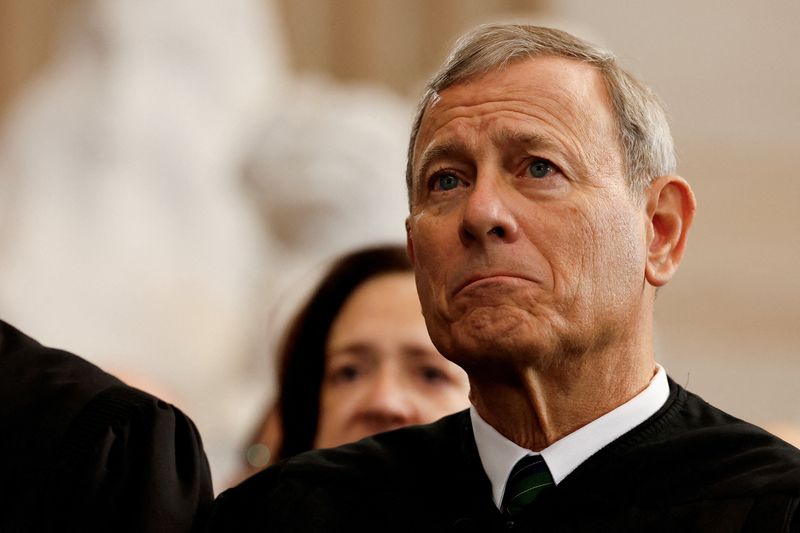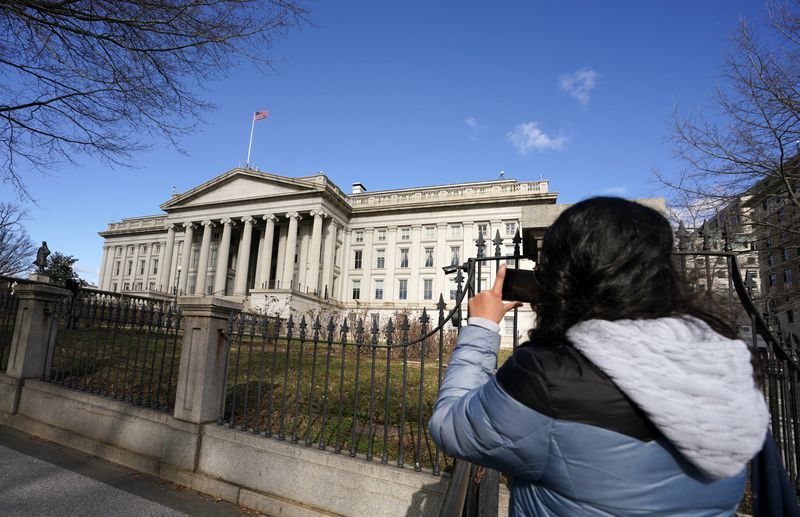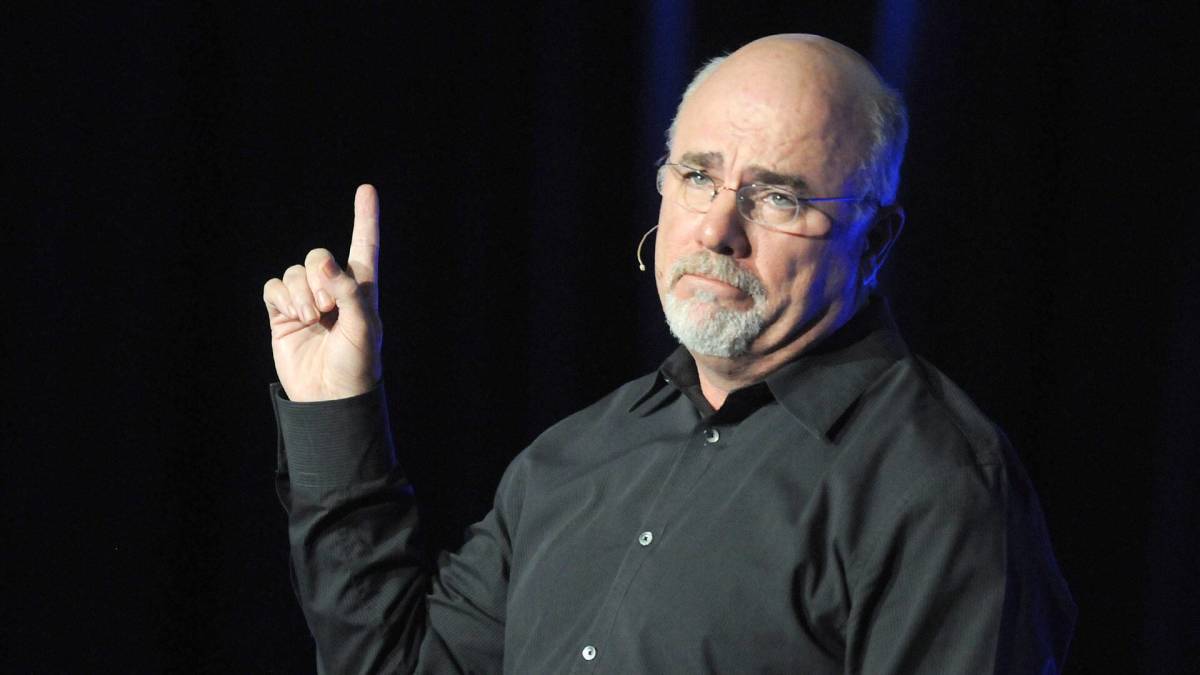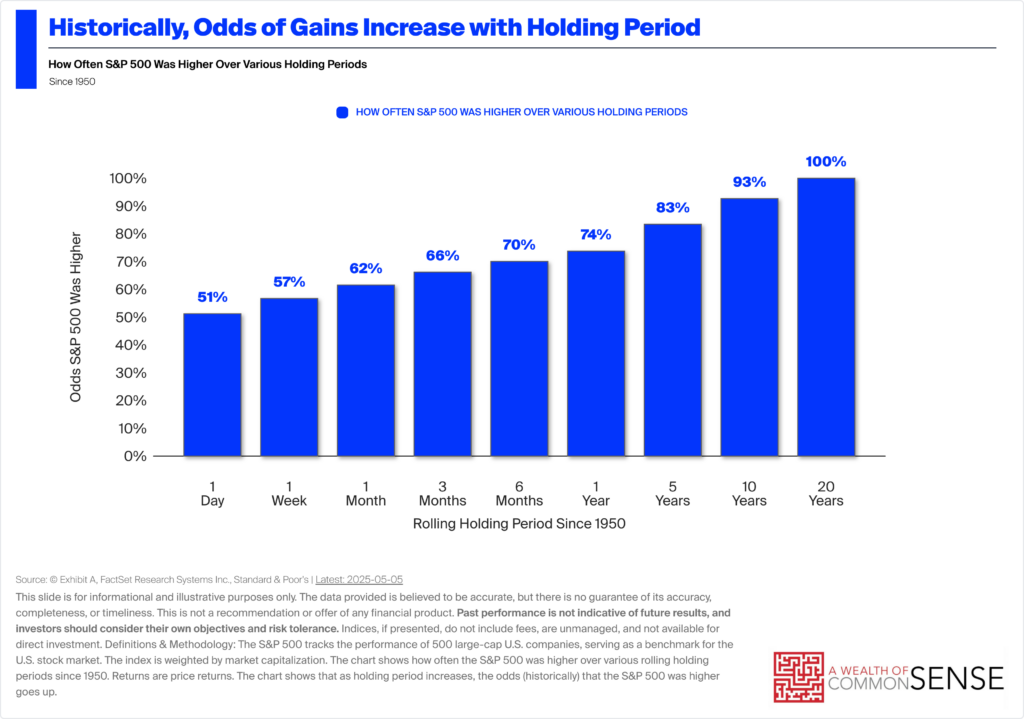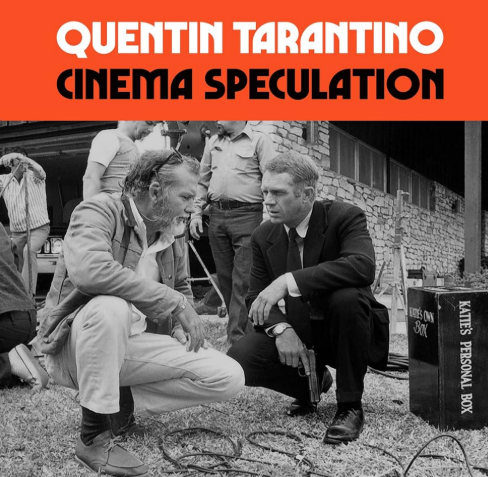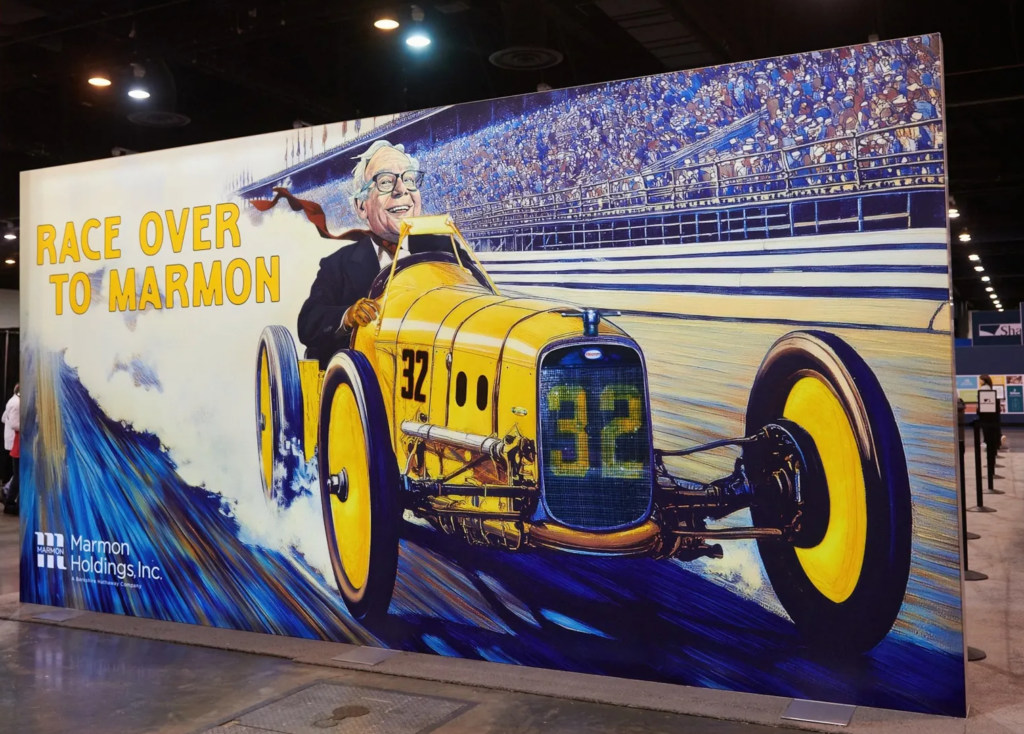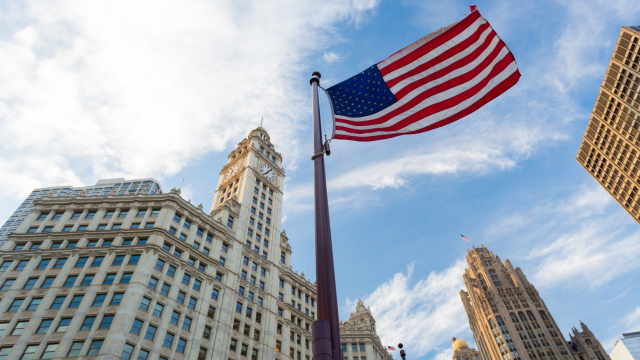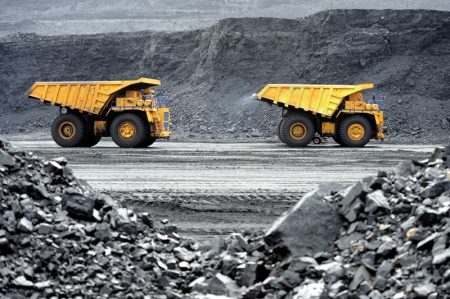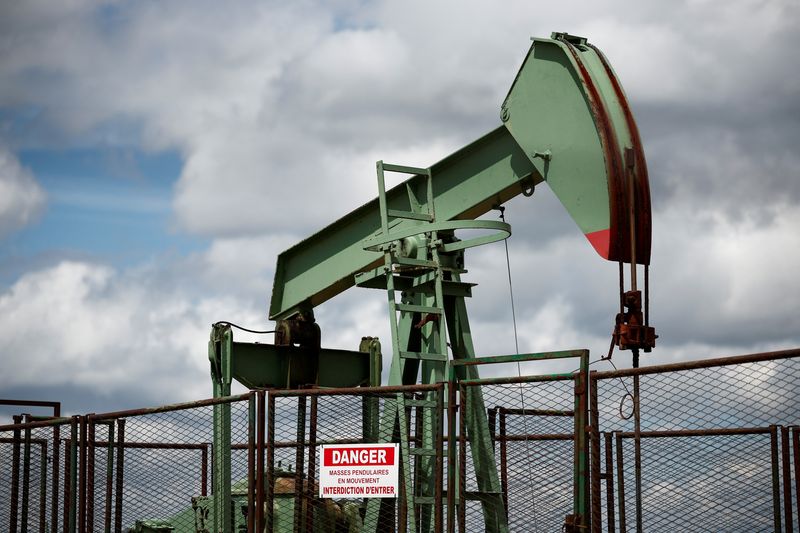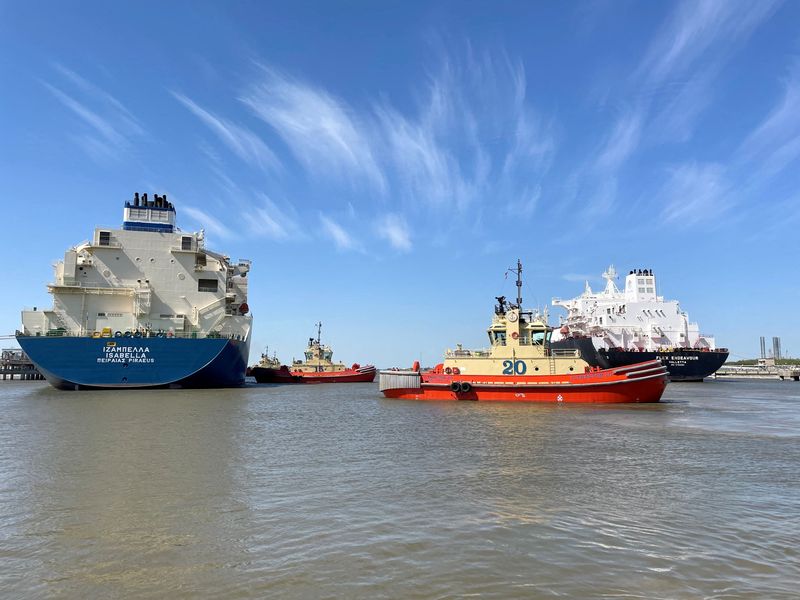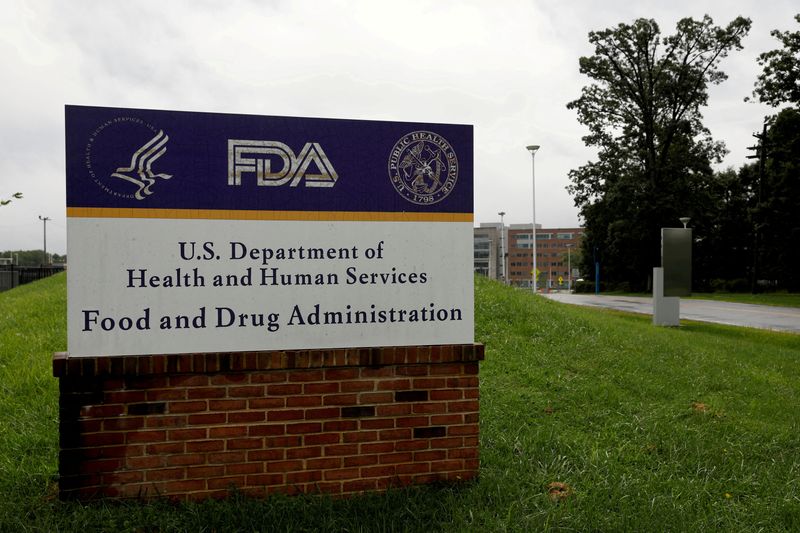New Orleans Is Still 100,000 People Smaller Than Before Katrina. Here Are Other Major Cities Still Recovering From Their Peak Population
24/7 Wall St. Insights While New Orleans has grown by 150,000 residents since Katrina, it is still far from its peak population. Like many great American cities, New Orleans’ population peaked in the mid-20th century. Many large American cities are still far from their peak size, despite recent population growth. Also: Discover the next Nvidia […] The post New Orleans Is Still 100,000 People Smaller Than Before Katrina. Here Are Other Major Cities Still Recovering From Their Peak Population appeared first on 24/7 Wall St..
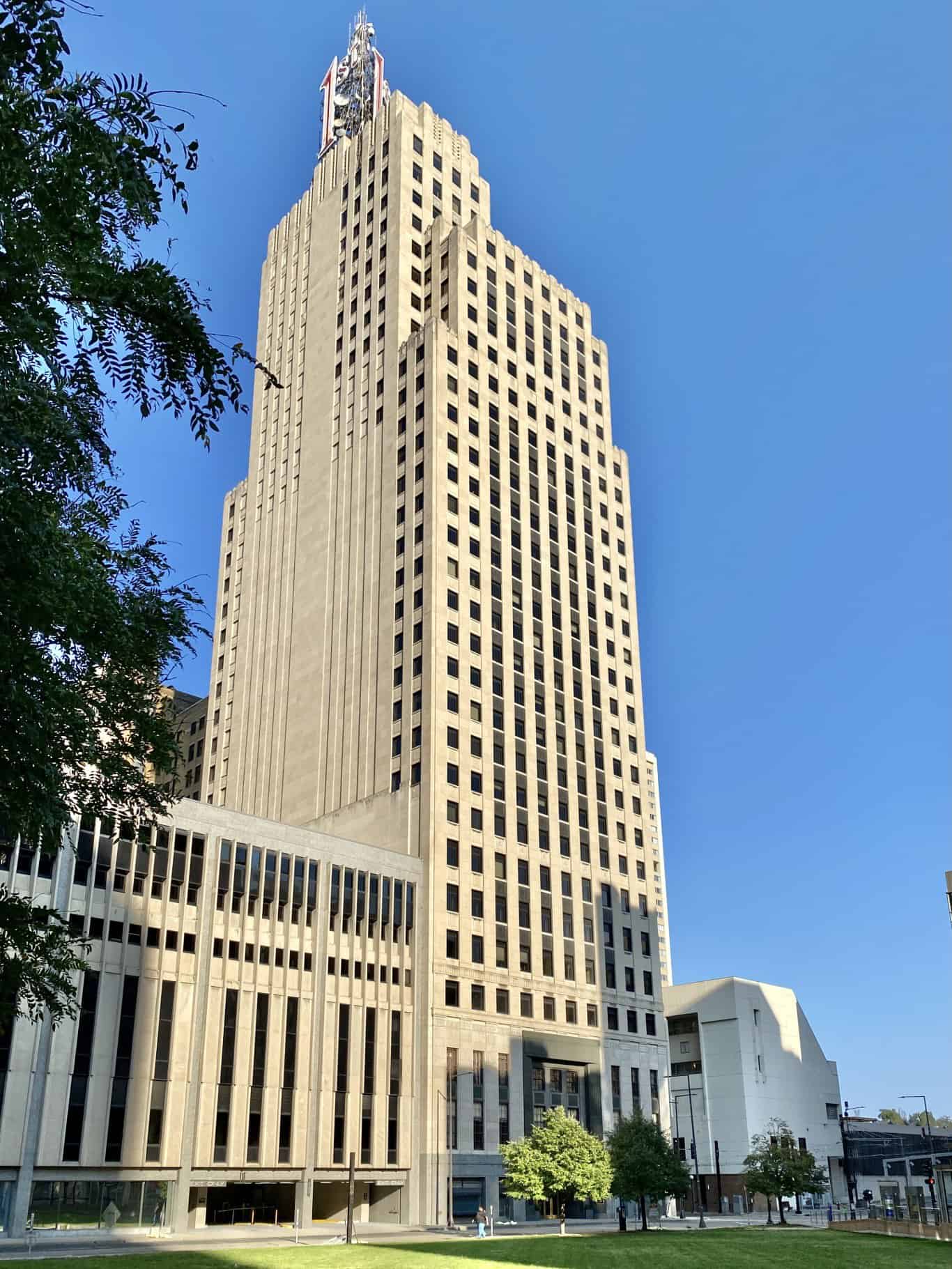
24/7 Wall St. Insights
- While New Orleans has grown by 150,000 residents since Katrina, it is still far from its peak population.
- Like many great American cities, New Orleans’ population peaked in the mid-20th century.
- Many large American cities are still far from their peak size, despite recent population growth.
- Also: Discover the next Nvidia
Over the past 20 years, the City of New Orleans has added about 150,000 residents. While the population has nearly doubled since its post-Katrine trough, New Orleans is still far from its peak size. Like many other great American cities, New Orleans peaked in the mid-20th century, spurred by a growing port economy and an increase in post-WWII industry, then weakened by the decline of manufacturing, urban disinvestment, and Hurricane Betsy and later Katrina.
Many of the cities with the largest population declines are former manufacturing hubs in the Rust Belt. A handful of mighty metros – such Chicago, Philadelphia, and Boston – are still hundreds of thousands of people smaller than their peaks, despite substantial population growth in the 21st century. A closer look at the data reveals the cities still recovering from their peak population.
To determine the cities still recovering from their peak population, 24/7 Wall St. reviewed historical population data from the U.S. Census Bureau. Cities were ranked based on total population decline from their peak populations. Peak population data are based on decennial census surveys going back to 1790, while data on current population are based on the 2023 American Community Survey.
40. Warren, MI

- Decline from peak population: -40,672 people
- Peak population: 179,260 (1970)
- Current population: 138,588
- Major events in city history: Rapid suburban growth in the 1950s and 1960s, opening of the General Motors Technical Center in 1956, decline of manufacturing jobs in the 1980s and 1990s, downtown revitalization projects in the 2010s
39. Wilmington, DE
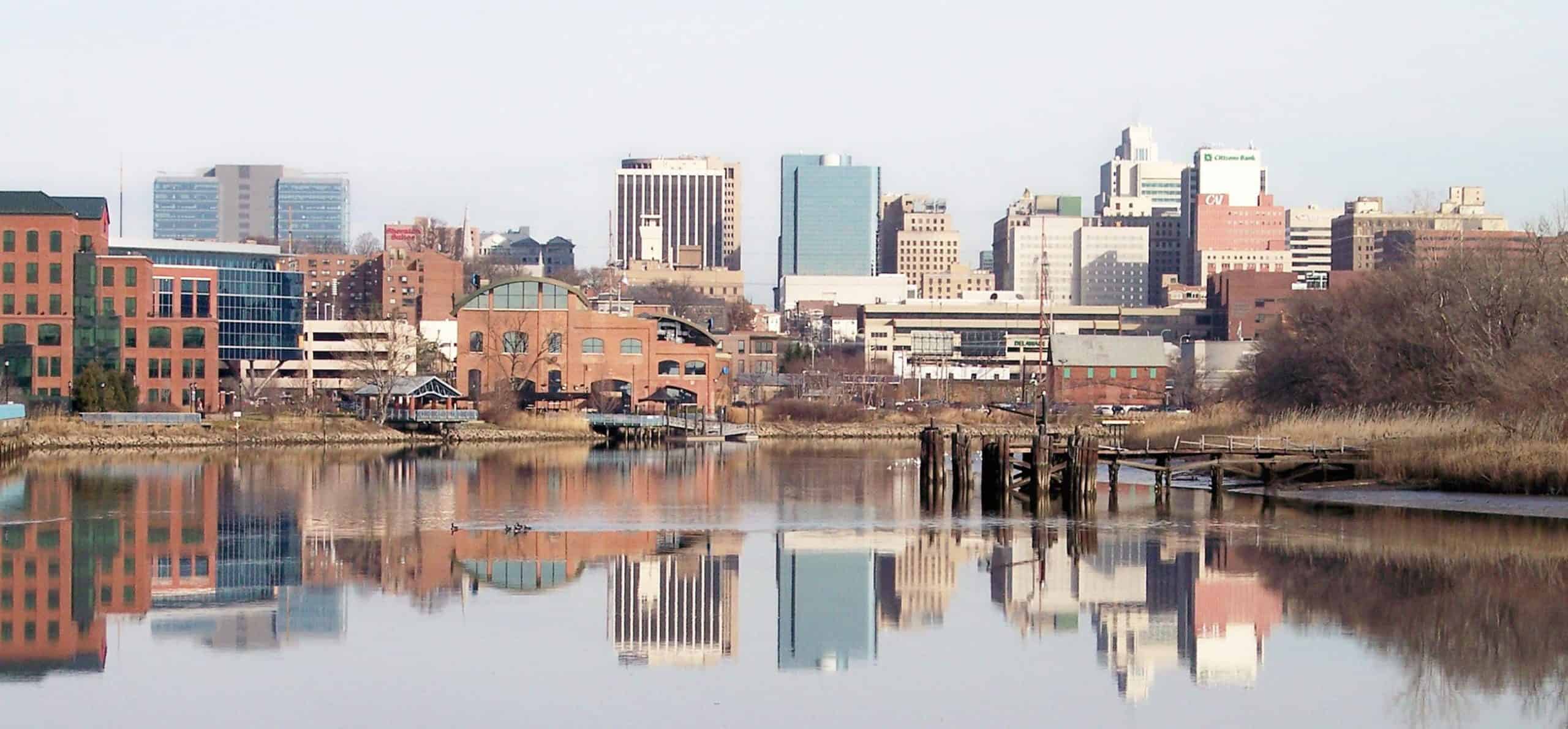
- Decline from peak population: -41,470 people
- Peak population: 112,504 (1940)
- Current population: 71,034
- Major events in city history: Founding of the DuPont Company in 1802, industrial growth along the Christina River in the 19th century, shipbuilding boom during World War II, economic diversification in the late 20th century, revitalization of the Riverfront District in the 2000s
38. Wilkes-Barre, PA
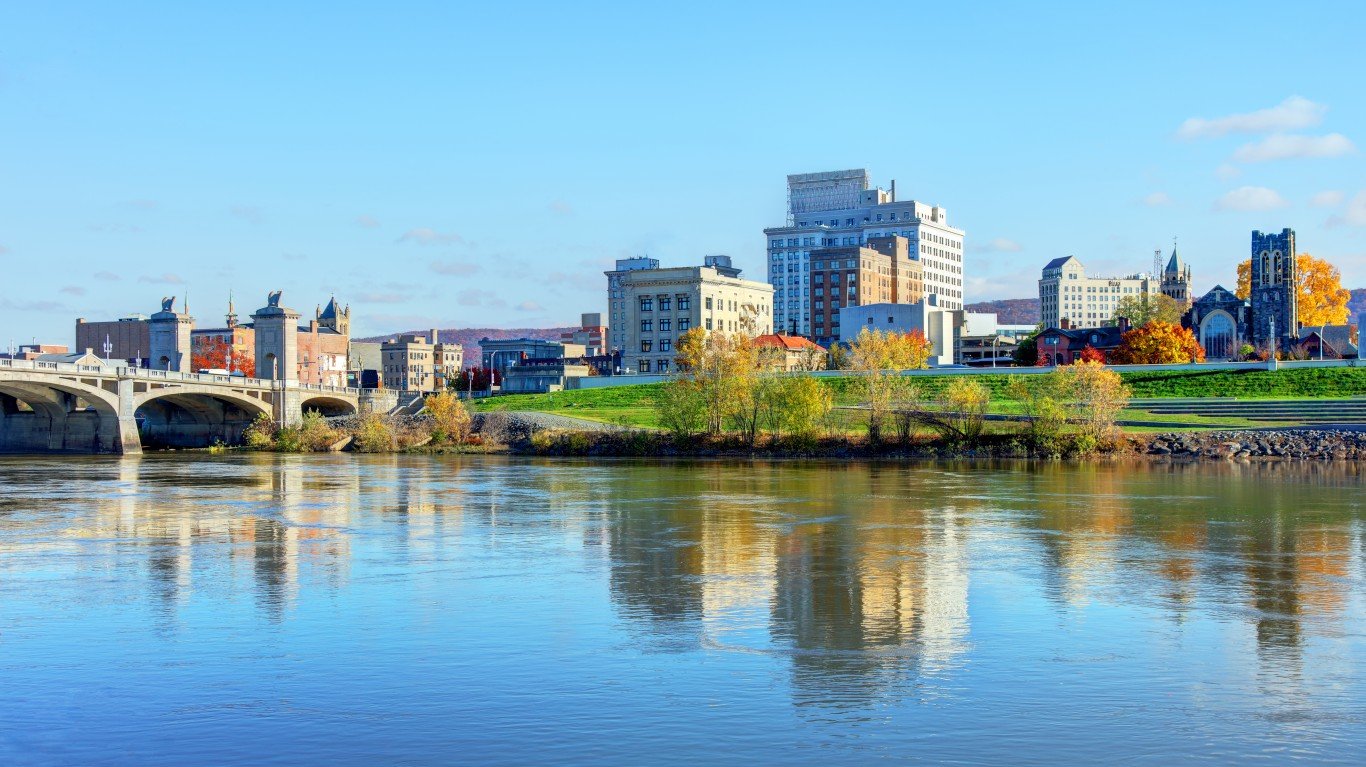
- Decline from peak population: -42,503 people
- Peak population: 86,626 (1930)
- Current population: 44,123
- Major events in city history: Coal mining boom in the late 19th and early 20th centuries, Knox Mine Disaster of 1959, flooding from Hurricane Agnes in 1972, economic decline with coal mine closures, efforts to revitalize downtown in the 21st century
37. Erie, PA
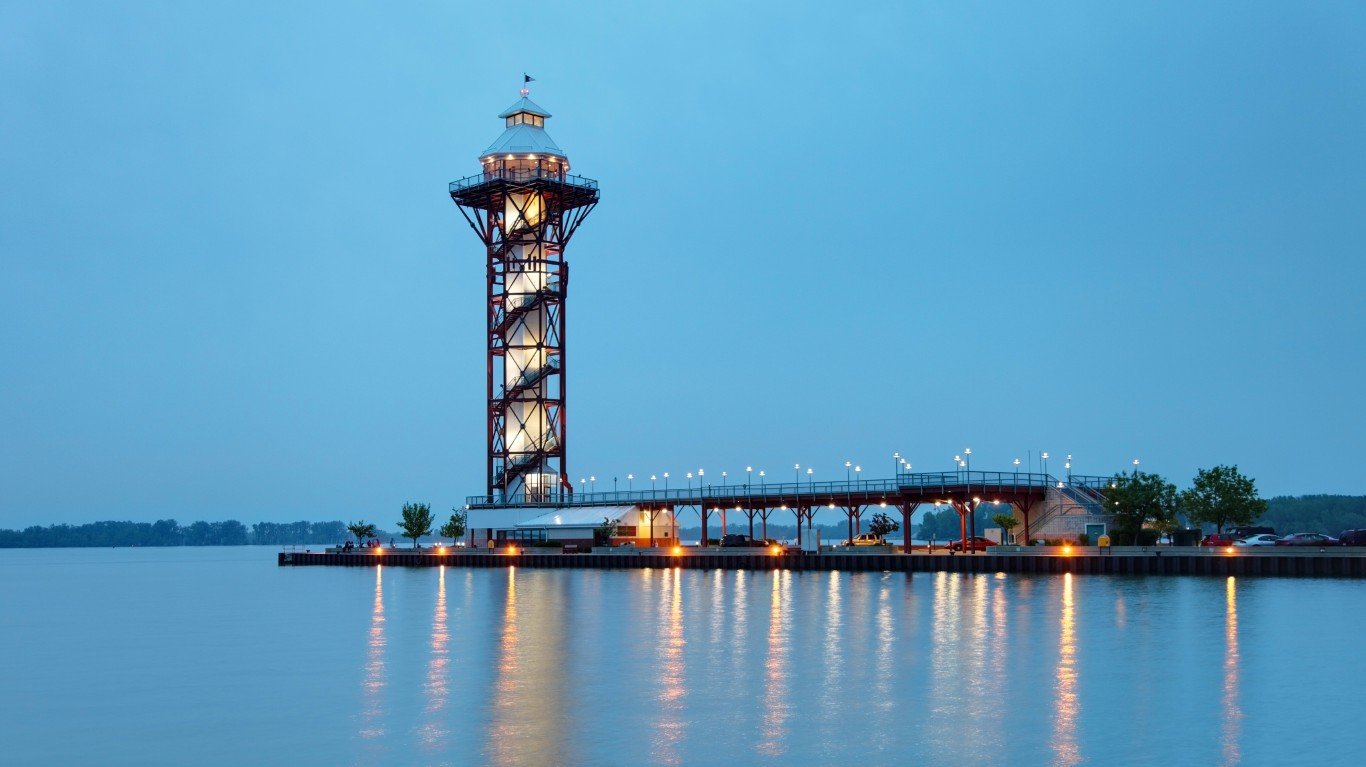
- Decline from peak population: -43,614 people
- Peak population: 138,440 (1960)
- Current population: 94,826
- Major events in city history: Establishment as a port city in the early 19th century, industrial growth with iron and steel production in the late 19th century, opening of Presque Isle State Park in 1921, decline of manufacturing in the 1970s, modern waterfront redevelopment initiatives
36. Highland Park, MI
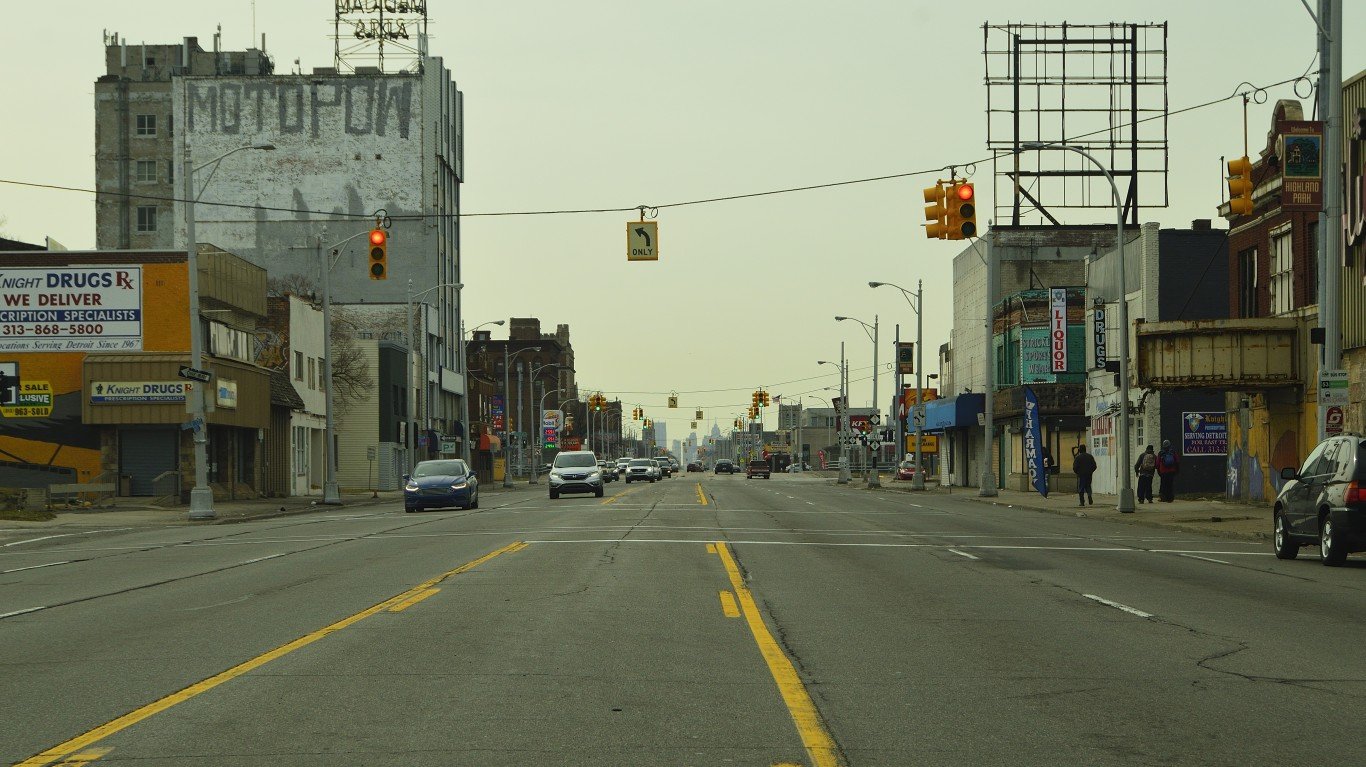
- Decline from peak population: -43,927 people
- Peak population: 52,959 (1930)
- Current population: 9,032
- Major events in city history: Ford Highland Park Plant opening in 1910, assembly line innovation at the Model T Plant in 1913, economic decline and plant closure in the late 20th century, revitalization efforts in the 21st century, community development initiatives in recent years
35. Canton, OH
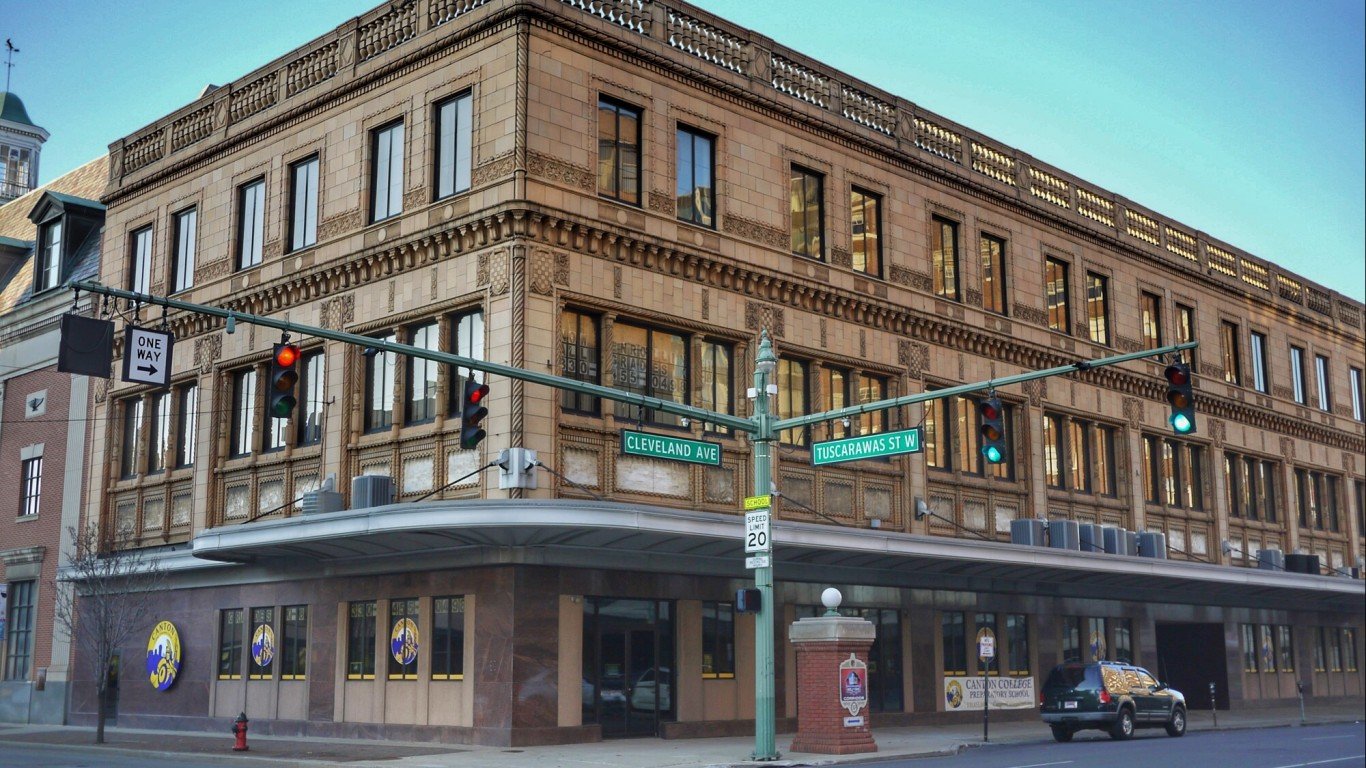
- Decline from peak population: -46,323 people
- Peak population: 116,912 (1950)
- Current population: 70,589
- Major events in city history: Founding of the Timken Company in 1899, opening of the Pro Football Hall of Fame in 1963, decline of manufacturing industries in the 1970s and 1980s, urban revitalization initiatives in the 2000s, expansion of the Hall of Fame Village in the 2010s
34. Johnstown, PA
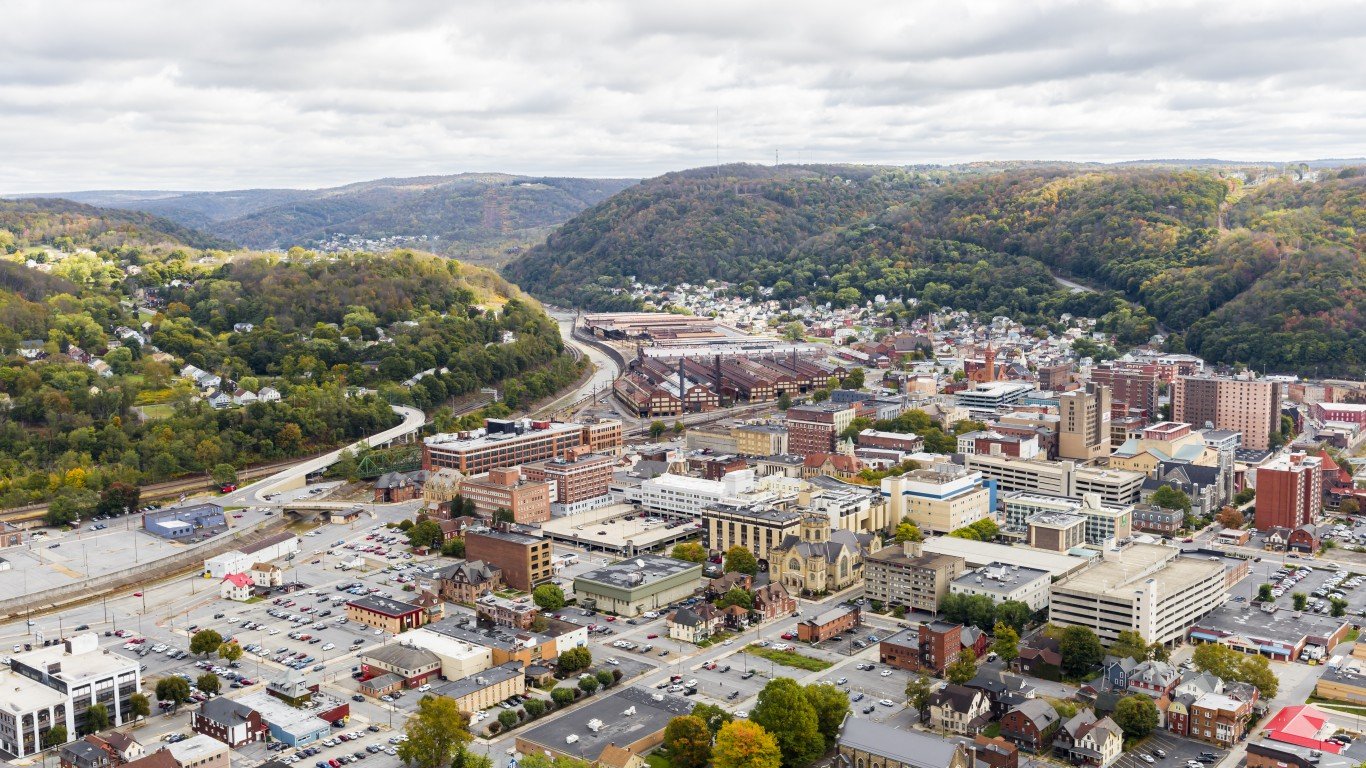
- Decline from peak population: -48,898 people
- Peak population: 67,327 (1920)
- Current population: 18,429
- Major events in city history: Johnstown Flood of 1889, Johnstown Flood of 1936, Johnstown Flood of 1977, steel industry decline in the 1970s and 1980s, ongoing flood mitigation and revitalization efforts
33. Jackson, MS
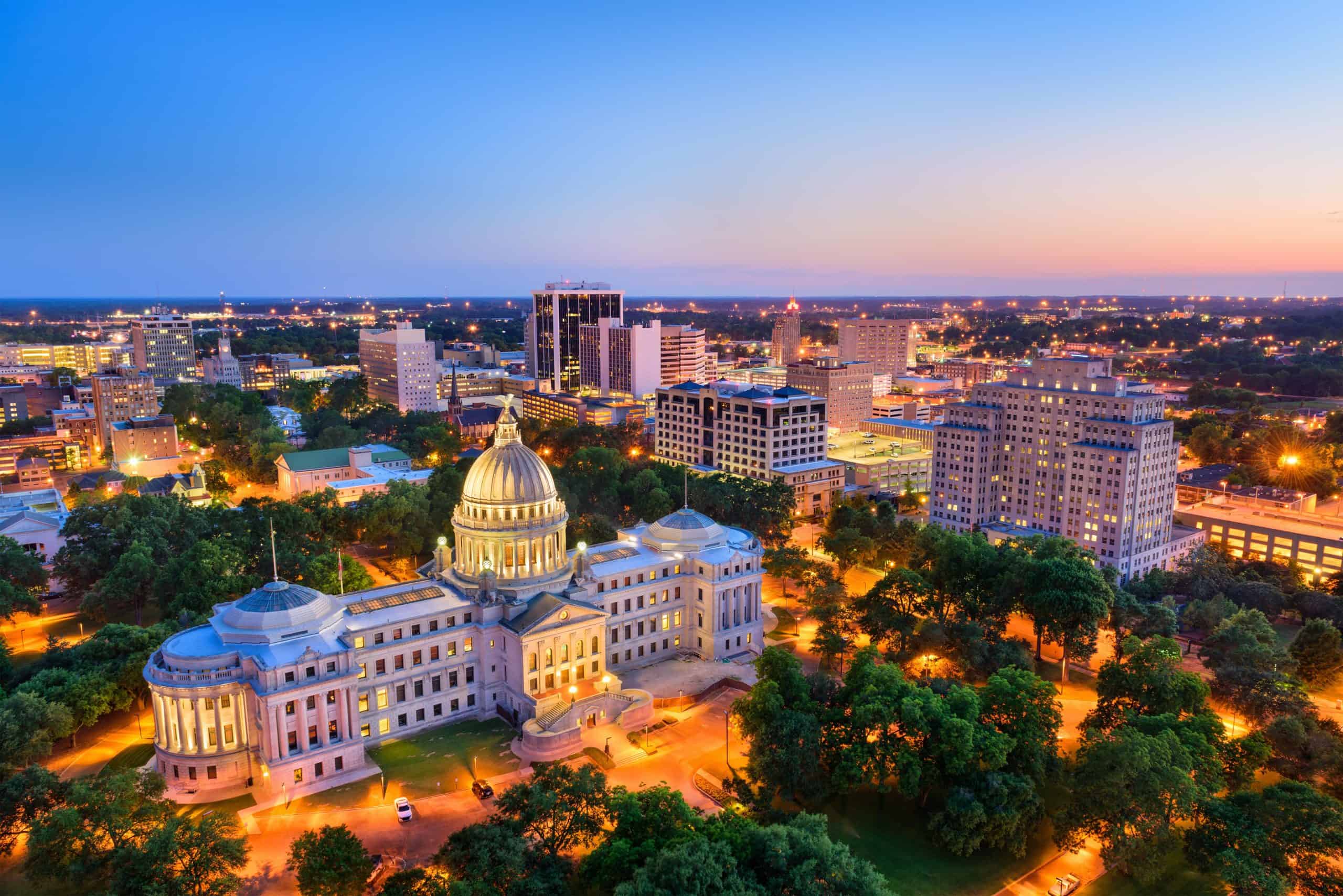
- Decline from peak population: -49,624 people
- Peak population: 202,895 (1980)
- Current population: 153,271
- Major events in city history: Founding as the state capital in 1821, Civil Rights Movement activism in the 1960s, Jackson State University shootings of 1970, severe flooding of the Pearl River in 1979, modern revitalization efforts in the downtown area
32. Camden, NJ
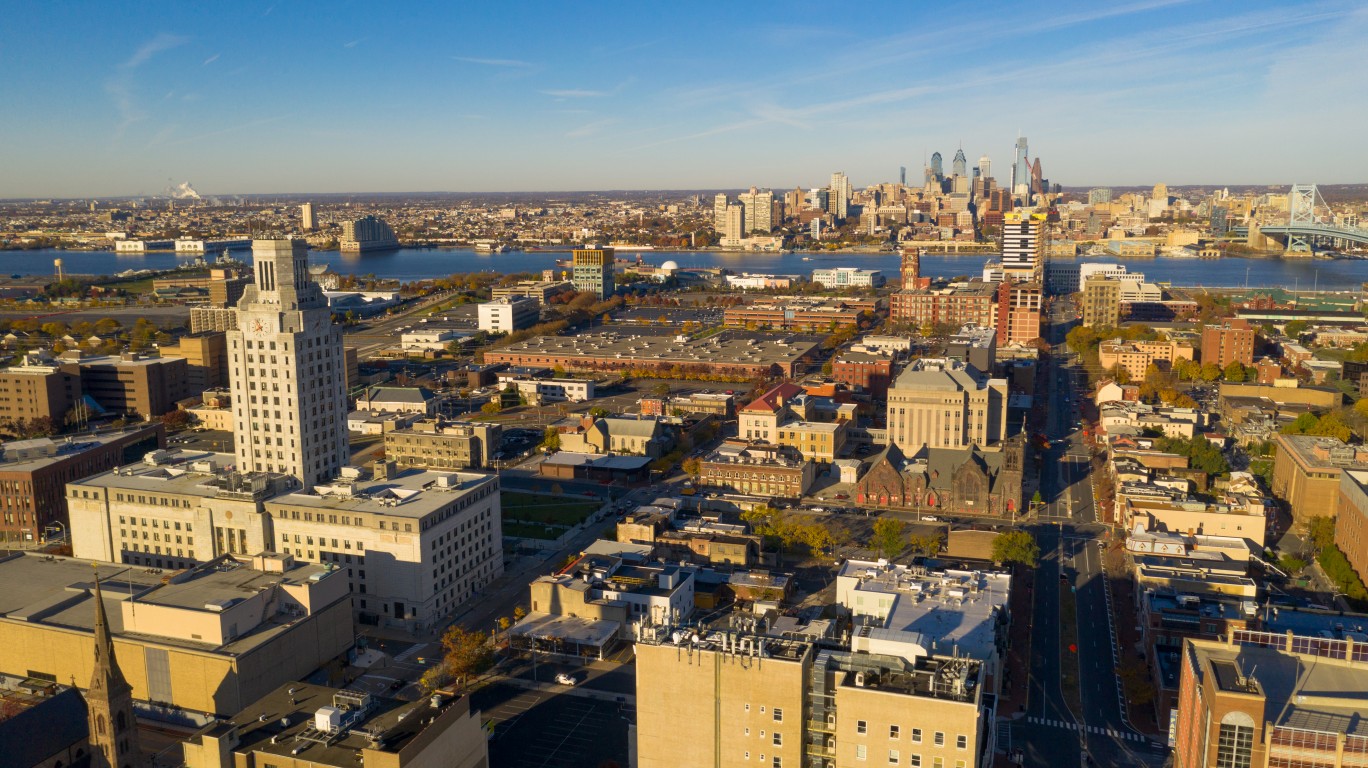
- Decline from peak population: -52,756 people
- Peak population: 124,555 (1950)
- Current population: 71,799
- Major events in city history: Founding of the Campbell Soup Company in 1869, establishment of RCA Victor in 1901, economic decline and urban decay in the mid-20th century, opening of the BB&T Pavilion in 1995, efforts to revitalize the waterfront in the 21st century
31. Niagara Falls, NY

- Decline from peak population: -53,892 people
- Peak population: 102,394 (1960)
- Current population: 48,502
- Major events in city history: Completion of the Niagara Falls Suspension Bridge in 1855, establishment of Niagara Reservation State Park in 1885, hydroelectric power development in the early 20th century, opening of the Robert Moses Niagara Power Plant in 1961, decline of the industrial economy in the late 20th century
30. Saginaw, MI
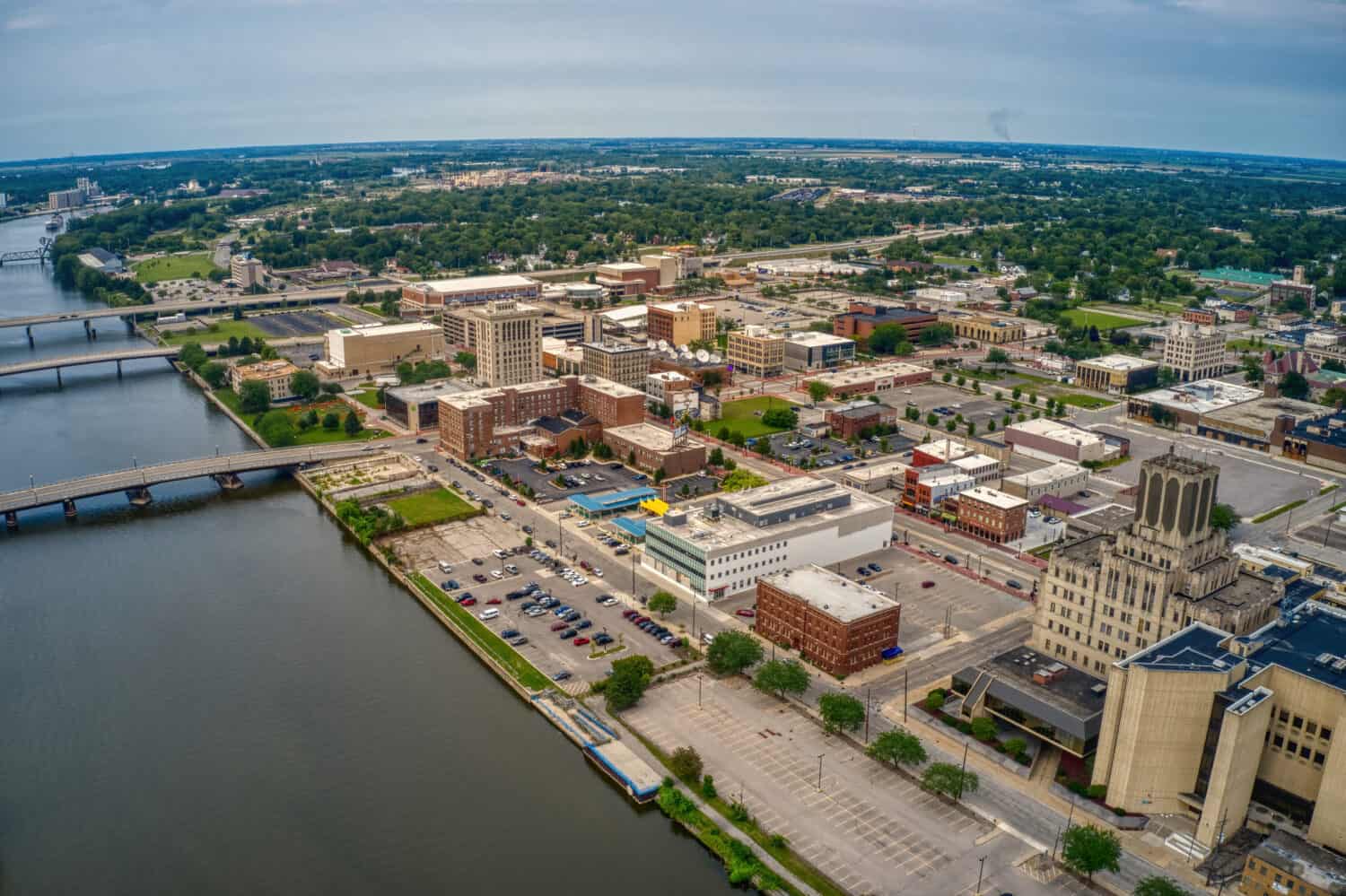
- Decline from peak population: -53,949 people
- Peak population: 98,265 (1960)
- Current population: 44,316
- Major events in city history: Lumber boom of the 19th century, Incorporation as a city in 1857, automobile manufacturing expansion in the early 20th century, closure of major auto plants in the 1980s, ongoing revitalization and economic challenges in the 21st century
29. Hartford, CT
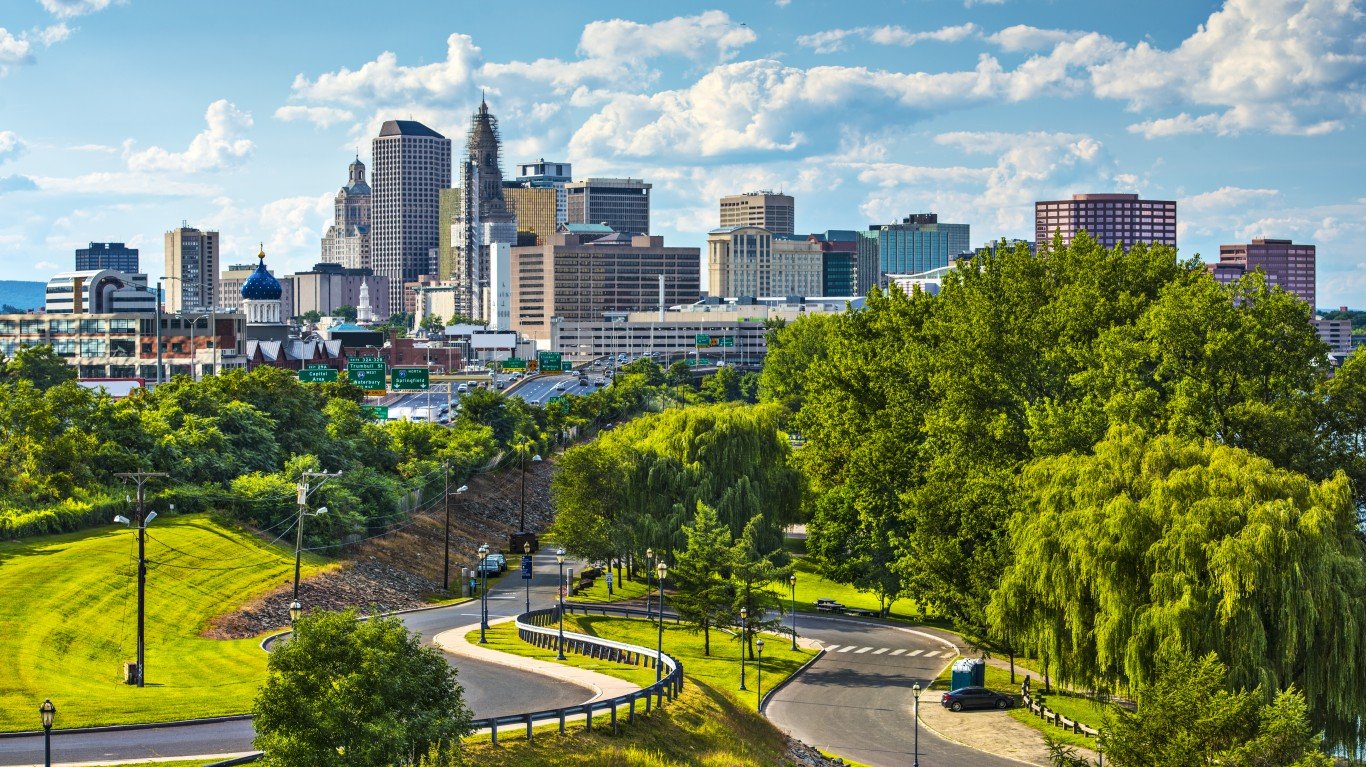
- Decline from peak population: -56,340 people
- Peak population: 177,397 (1950)
- Current population: 121,057
- Major events in city history: Founding of the Hartford Courant in 1764, Charter Oak incident in 1687, insurance industry growth in the 19th century, Hartford circus fire of 1944, economic decline and revitalization in the late 20th century
28. East St. Louis, IL
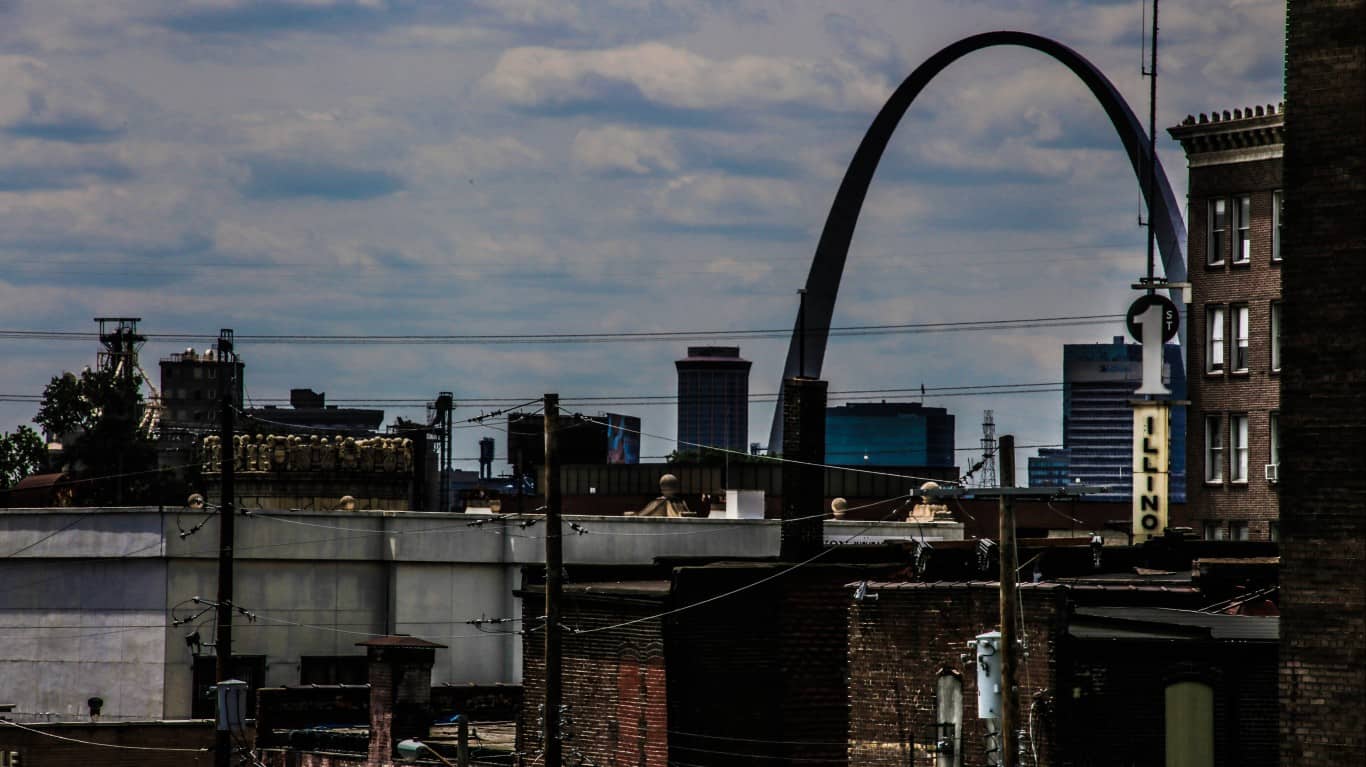
- Decline from peak population: -63,499 people
- Peak population: 82,295 (1950)
- Current population: 18,796
- Major events in city history: Industrial boom in the late 19th and early 20th centuries, East St. Louis Race Riots of 1917, decline of the steel industry in the 1970s, economic collapse in the 1980s, revitalization and urban renewal efforts in the 21st century
27. Providence, RI
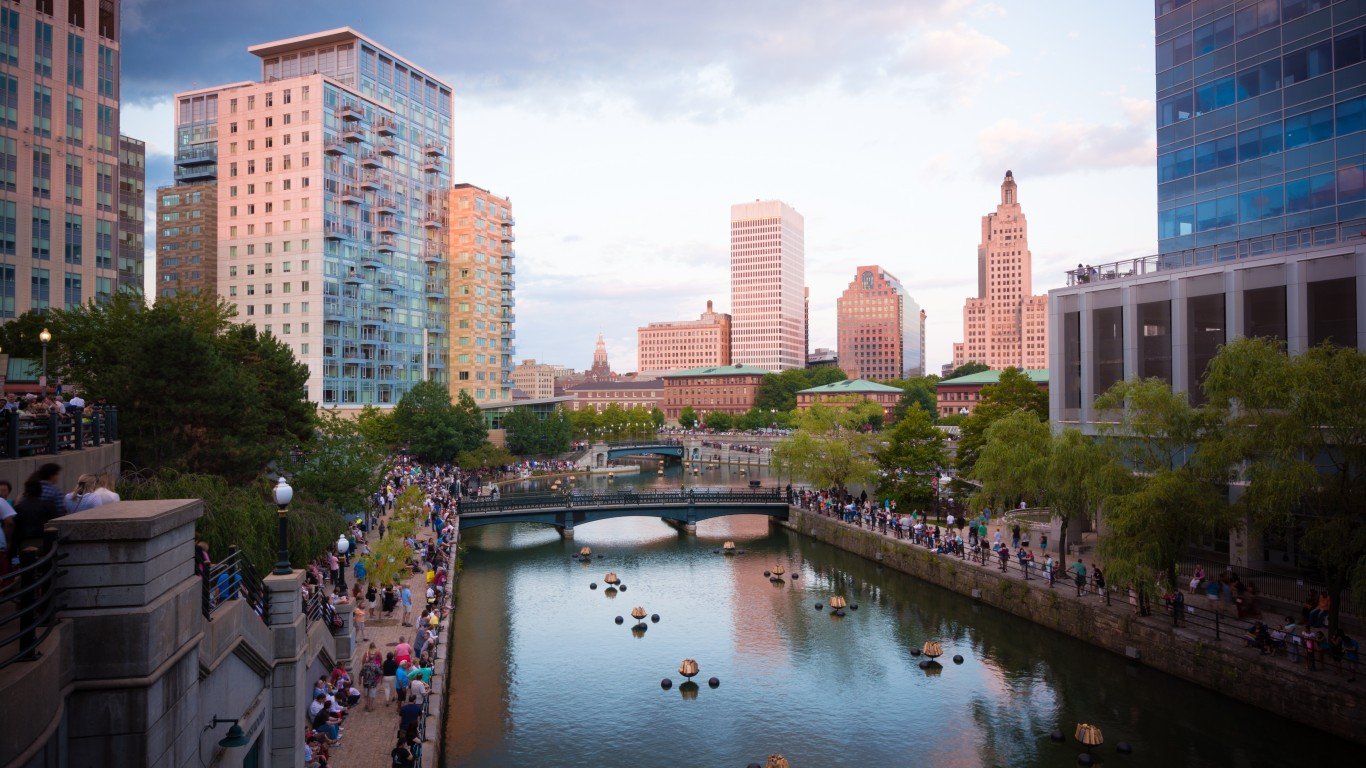
- Decline from peak population: -63,789 people
- Peak population: 253,504 (1940)
- Current population: 189,715
- Major events in city history: Founding of Brown University in 1764, Industrial Revolution textile mills in the early 19th century, Great Fire of 1872, completion of the Providence River relocation project in 1996, revitalization of Waterplace Park and Riverwalk in the 1990s
26. Scranton, PA
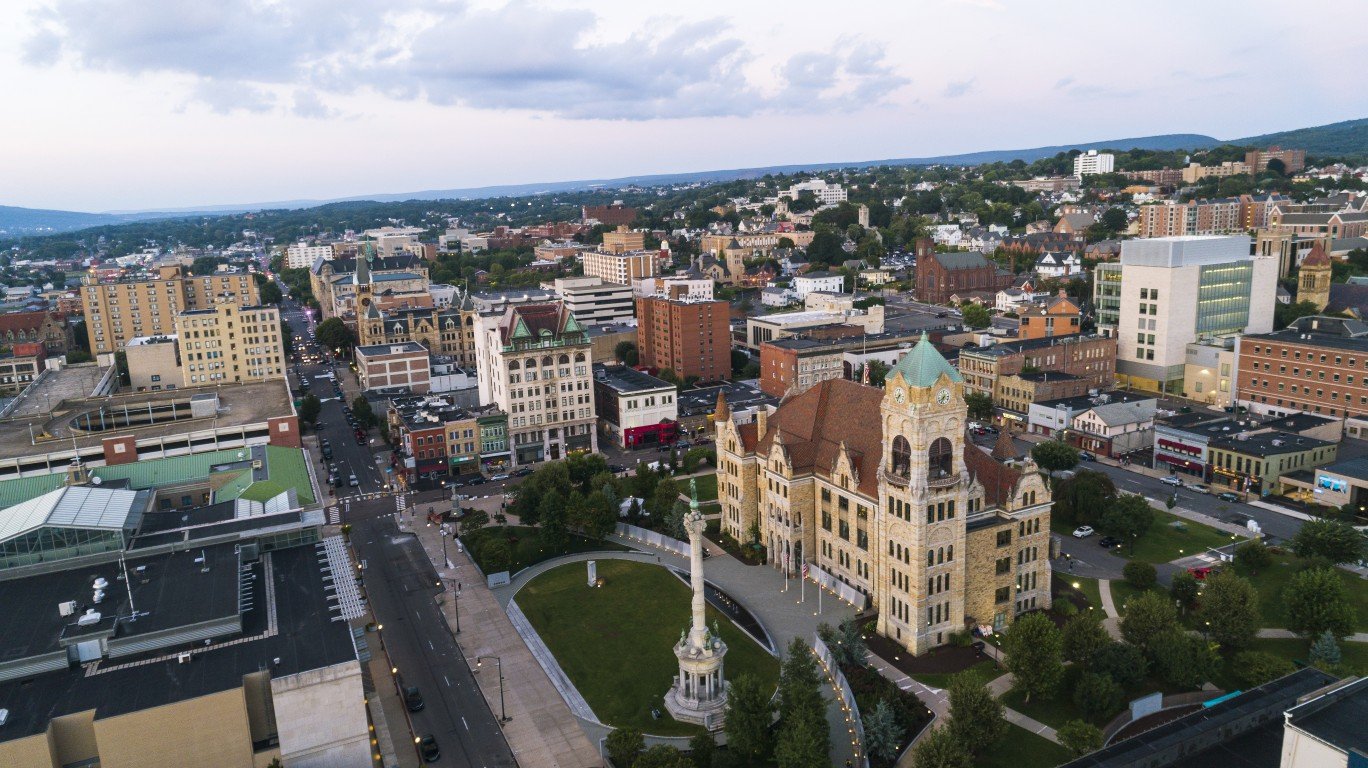
- Decline from peak population: -67,314 people
- Peak population: 143,433 (1930)
- Current population: 76,119
- Major events in city history: Founding of the Delaware, Lackawanna and Western Railroad in 1851, anthracite coal mining boom in the late 19th century, electric streetcar system established in 1886, Scranton General Strike of 1877, closure of coal mines in the mid-20th century
25. Norfolk, VA
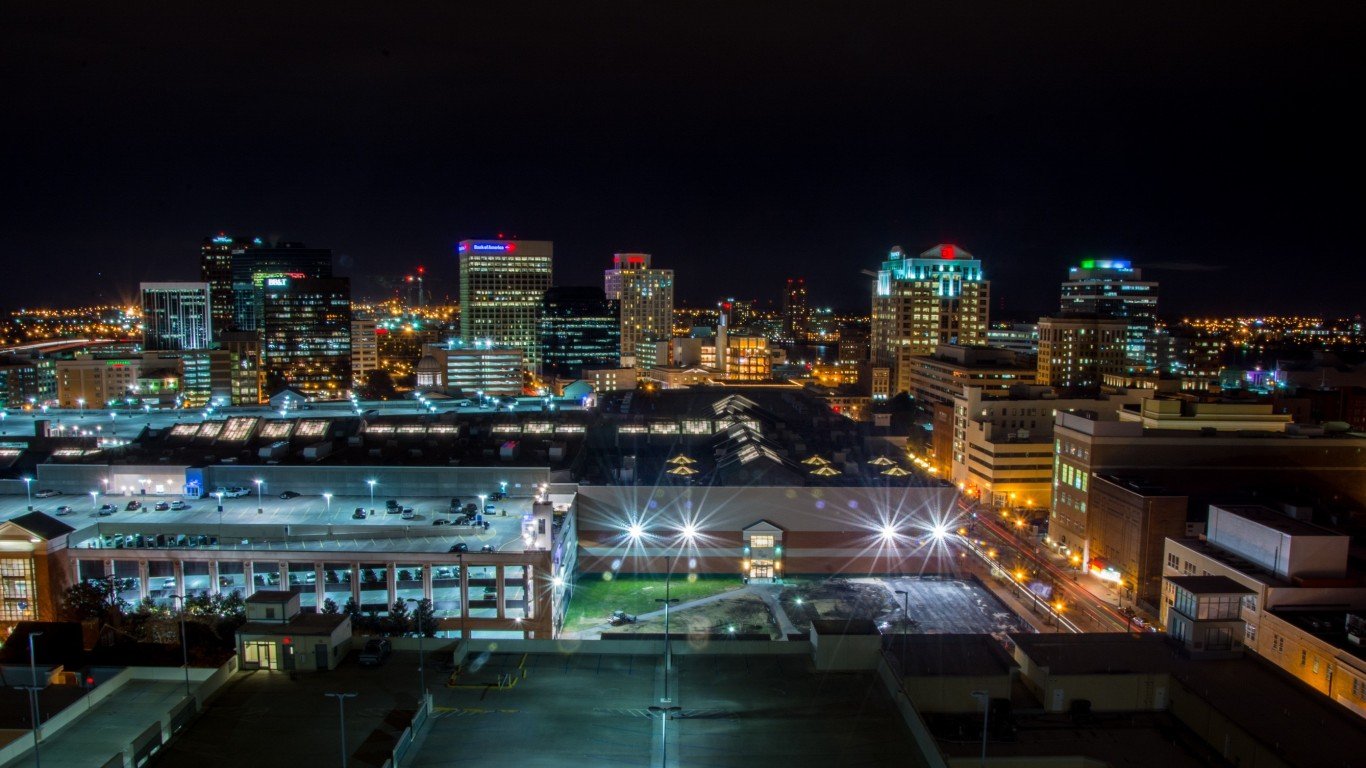
- Decline from peak population: -70,978 people
- Peak population: 307,951 (1970)
- Current population: 236,973
- Major events in city history: Battle of Hampton Roads in 1862, establishment of Norfolk Naval Shipyard in 1767, opening of the Hampton Roads Bridge-Tunnel in 1957, expansion of the Port of Virginia in the 21st century
24. Syracuse, NY
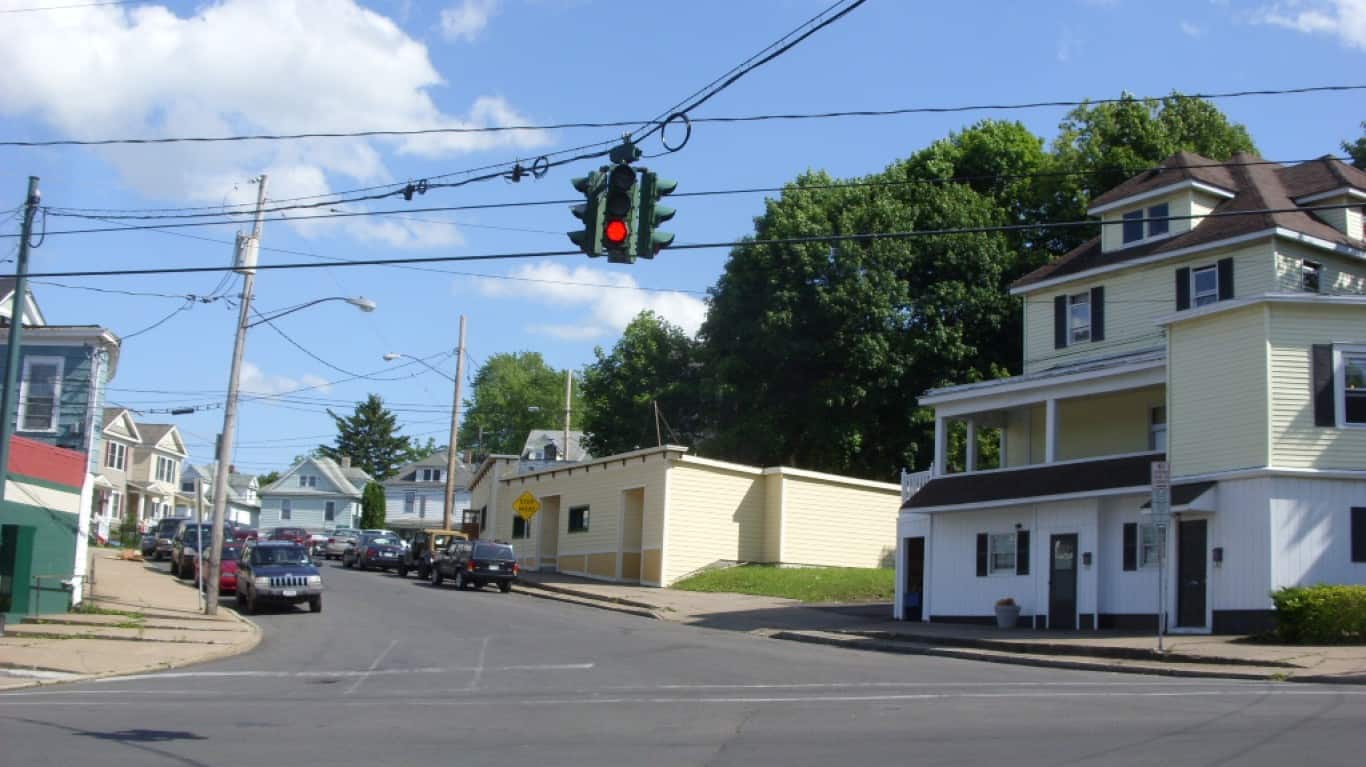
- Decline from peak population: -74,449 people
- Peak population: 220,583 (1950)
- Current population: 146,134
- Major events in city history: Completion of the Erie Canal through Syracuse in 1825, founding of Syracuse University in 1870, Jerry Rescue of 1851, establishment of Carrier Corporation in 1915, Urban renewal projects in the 1950s and 1960s
23. Minneapolis, MN
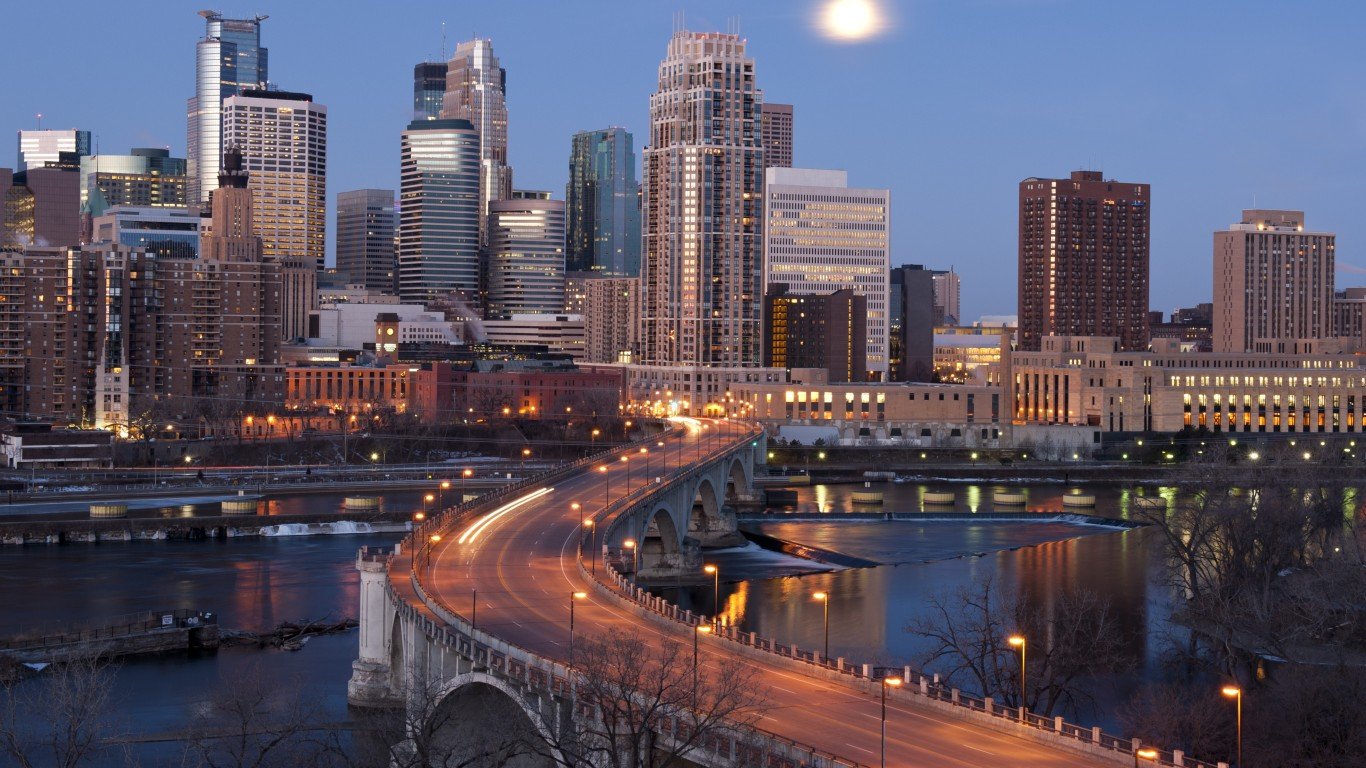
- Decline from peak population: -94,841 people
- Peak population: 521,718 (1950)
- Current population: 426,877
- Major events in city history: Founding of Pillsbury Company in 1869, Minneapolis General Strike of 1934, opening of the Guthrie Theater in 1963, collapse of the I-35W Mississippi River bridge in 2007, George Floyd protests in 2020
22. Akron, OH
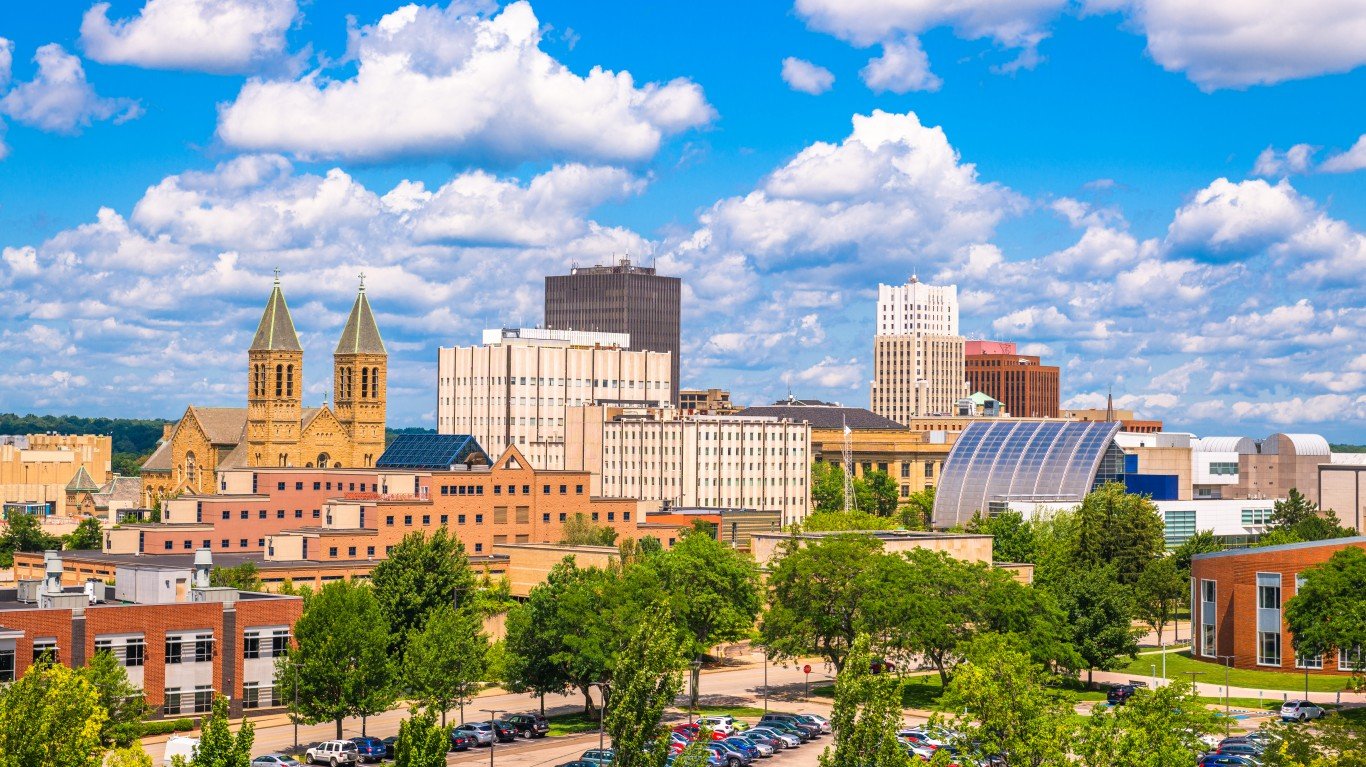
- Decline from peak population: -100,078 people
- Peak population: 290,351 (1960)
- Current population: 190,273
- Major events in city history: Establishment of B.F. Goodrich Company in 1870, founding of Goodyear Tire & Rubber Company in 1898, Rubber Strike of 1936, Akron’s designation as the ‘Rubber Capital of the World’ in the early 20th century, opening of the Akron Art Museum in 1922
21. Gary, IN
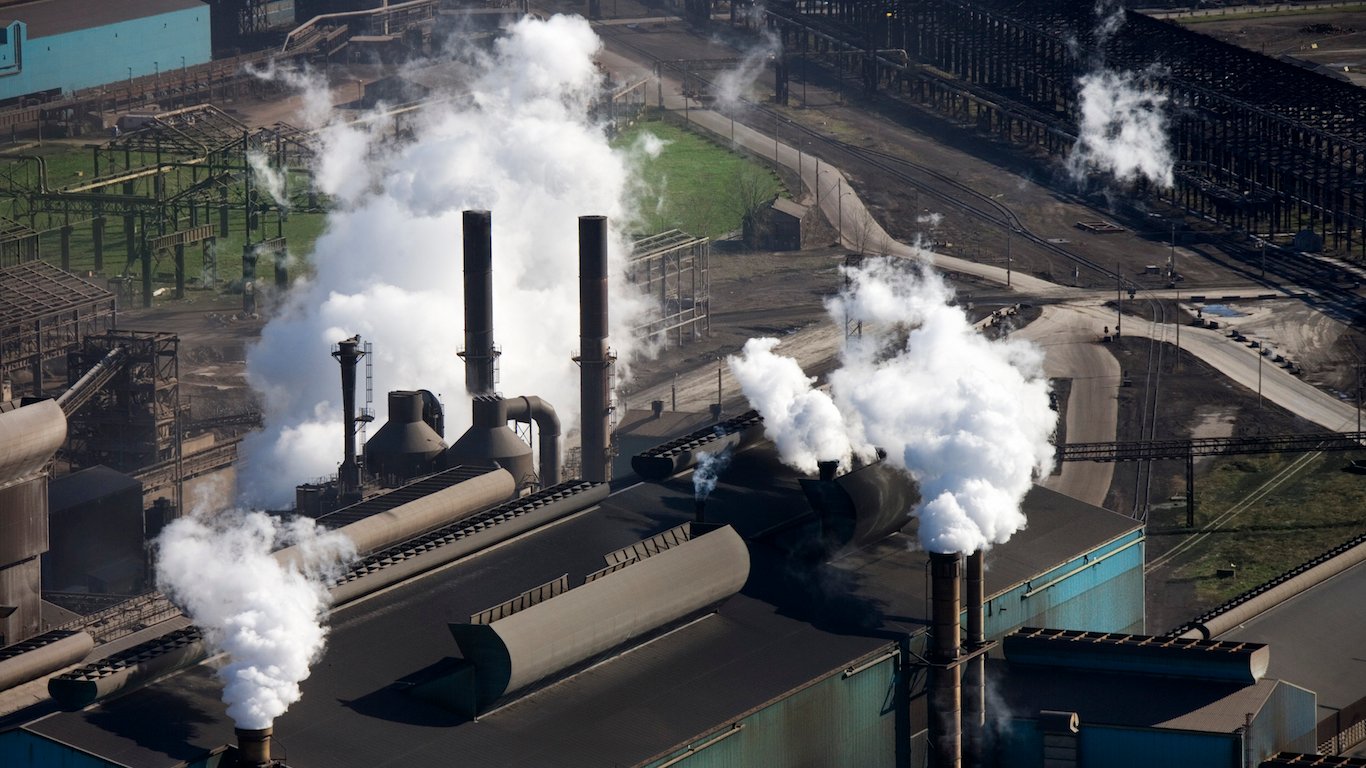
- Decline from peak population: -109,184 people
- Peak population: 178,320 (1960)
- Current population: 69,136
- Major events in city history: Founding of the city by U.S. Steel Corporation in 1906, opening of the Gary Works steel mill in 1908, Steel Strike of 1919, decline of the steel industry in the 1970s and 1980s, ongoing revitalization efforts in the 21st century
20. Youngstown, OH
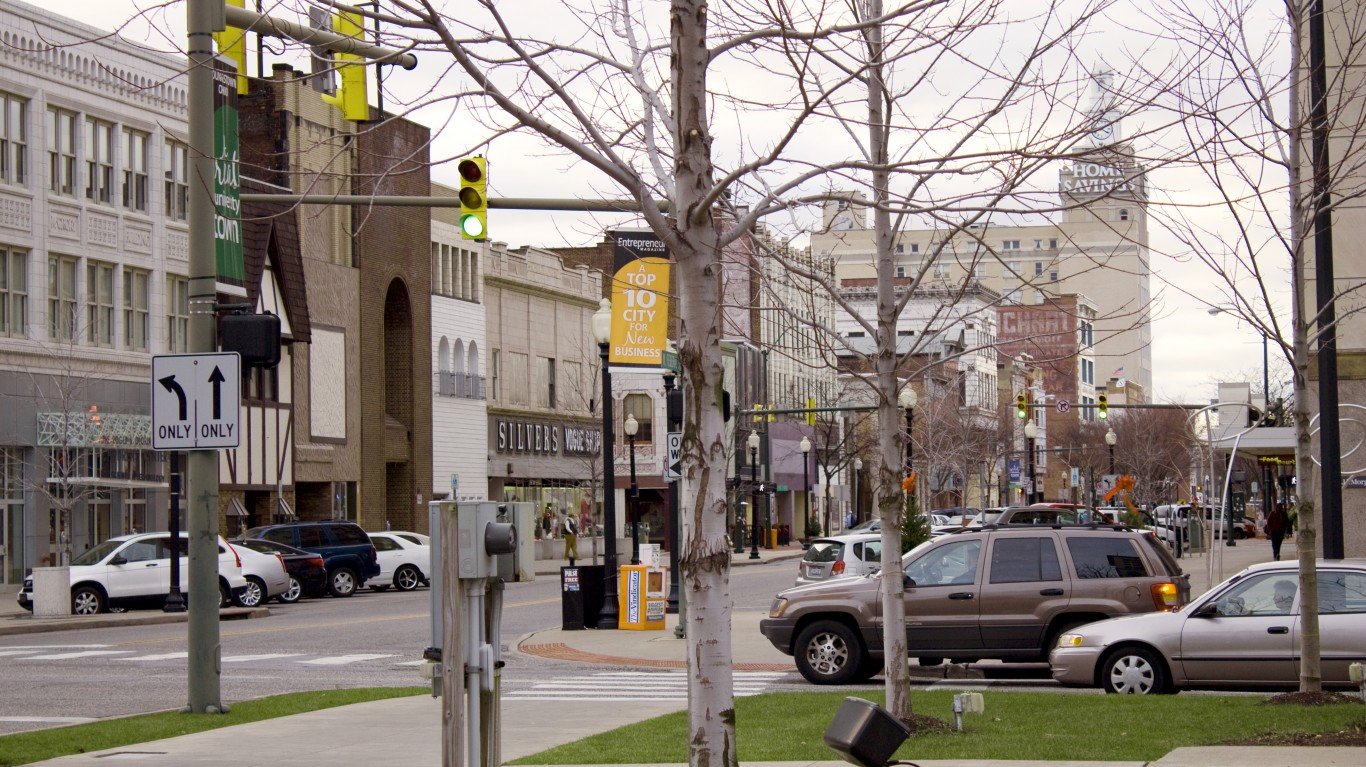
- Decline from peak population: -109,954 people
- Peak population: 170,002 (1930)
- Current population: 60,048
- Major events in city history: Founding of the Youngstown Sheet and Tube Company in 1900, Little Steel Strike of 1937, Black Monday steel mill closures in 1977, establishment of Youngstown State University in 1908, opening of the Covelli Centre in 2005
19. Toledo, OH
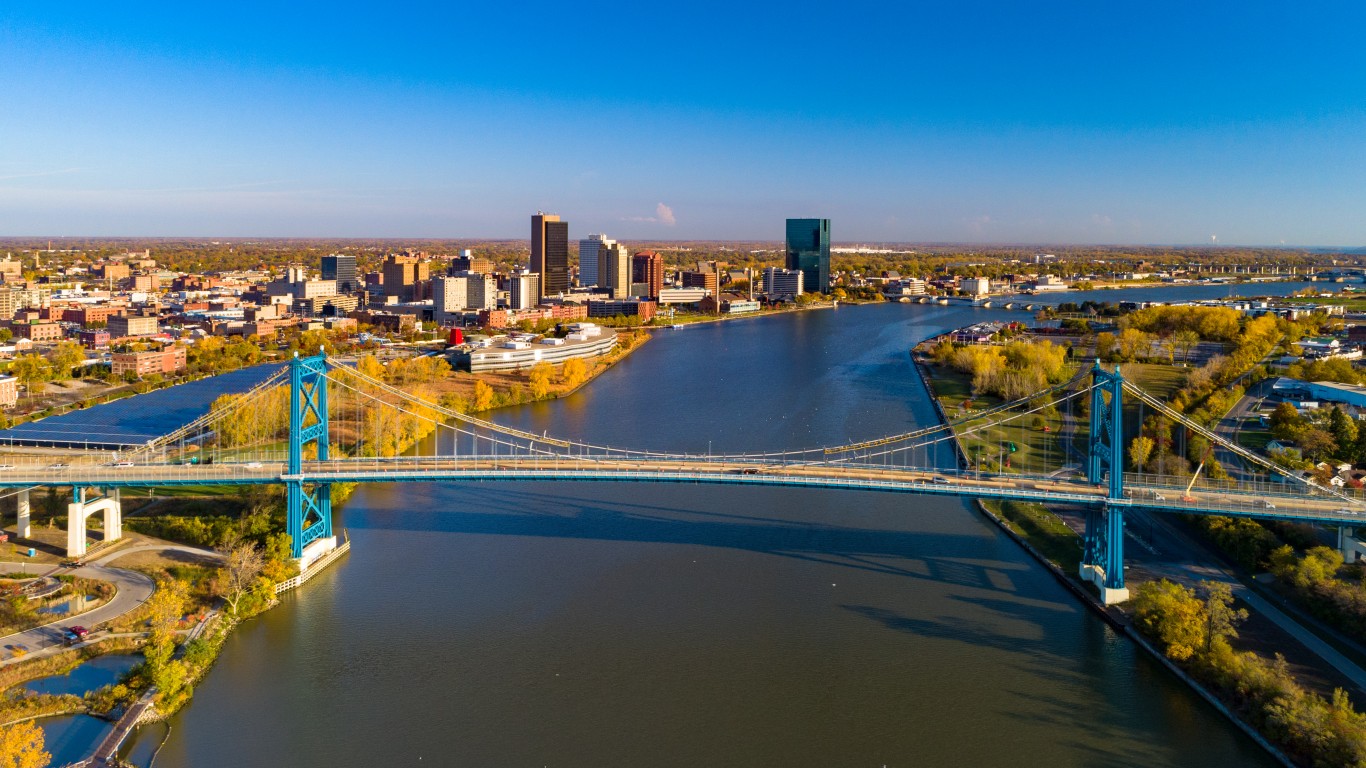
- Decline from peak population: -113,100 people
- Peak population: 383,062 (1970)
- Current population: 269,962
- Major events in city history: The Toledo War (1835-1836), completion of the Miami and Erie Canal in 1845, Auto-Lite strike of 1934, opening of the Toledo Museum of Art in 1901, establishment of the Jeep headquarters and manufacturing plant in 1941
18. Flint, MI
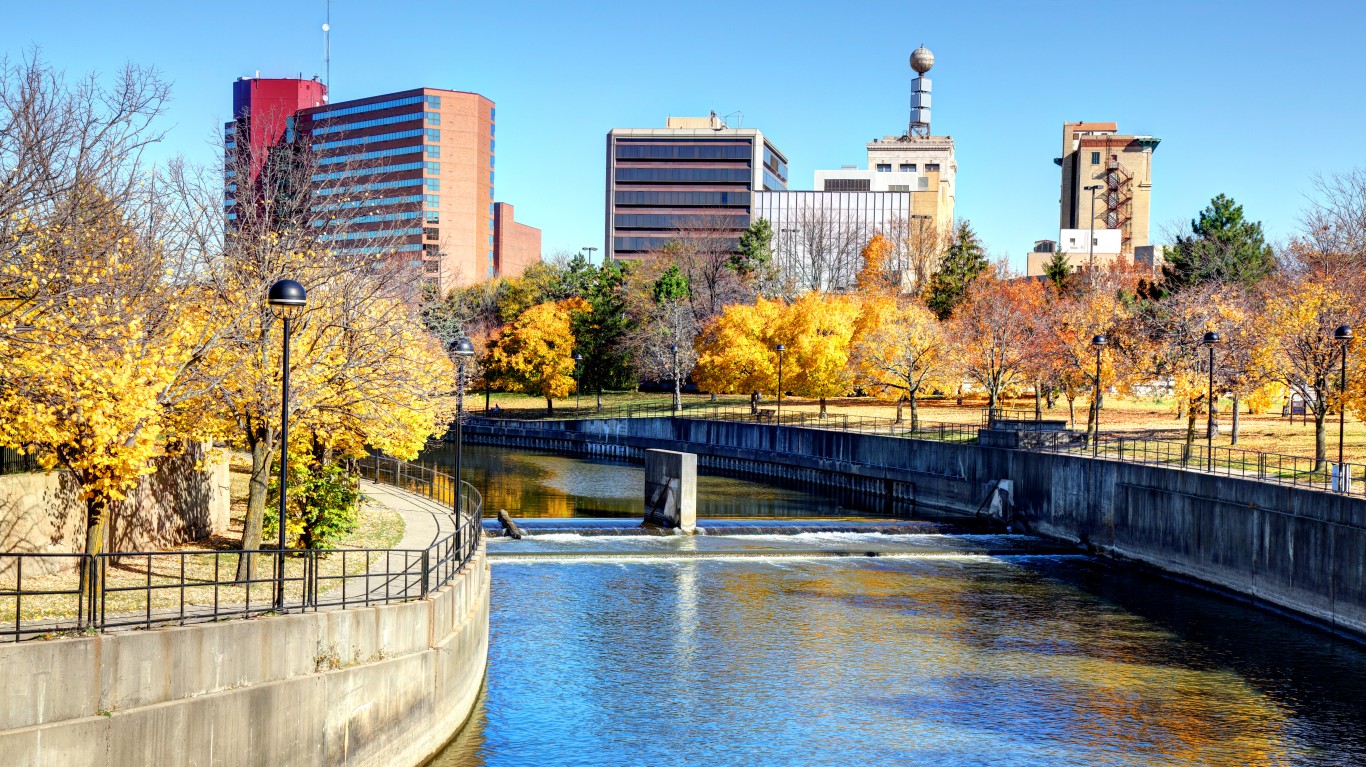
- Decline from peak population: -115,077 people
- Peak population: 196,940 (1960)
- Current population: 81,863
- Major events in city history: Flint Sit-Down Strike of 1936-1937, establishment of General Motors in 1908, founding of the United Auto Workers (UAW) in 1935, closure of Buick City assembly plant in 1999, Flint water crisis beginning in 2014
17. Rochester, NY
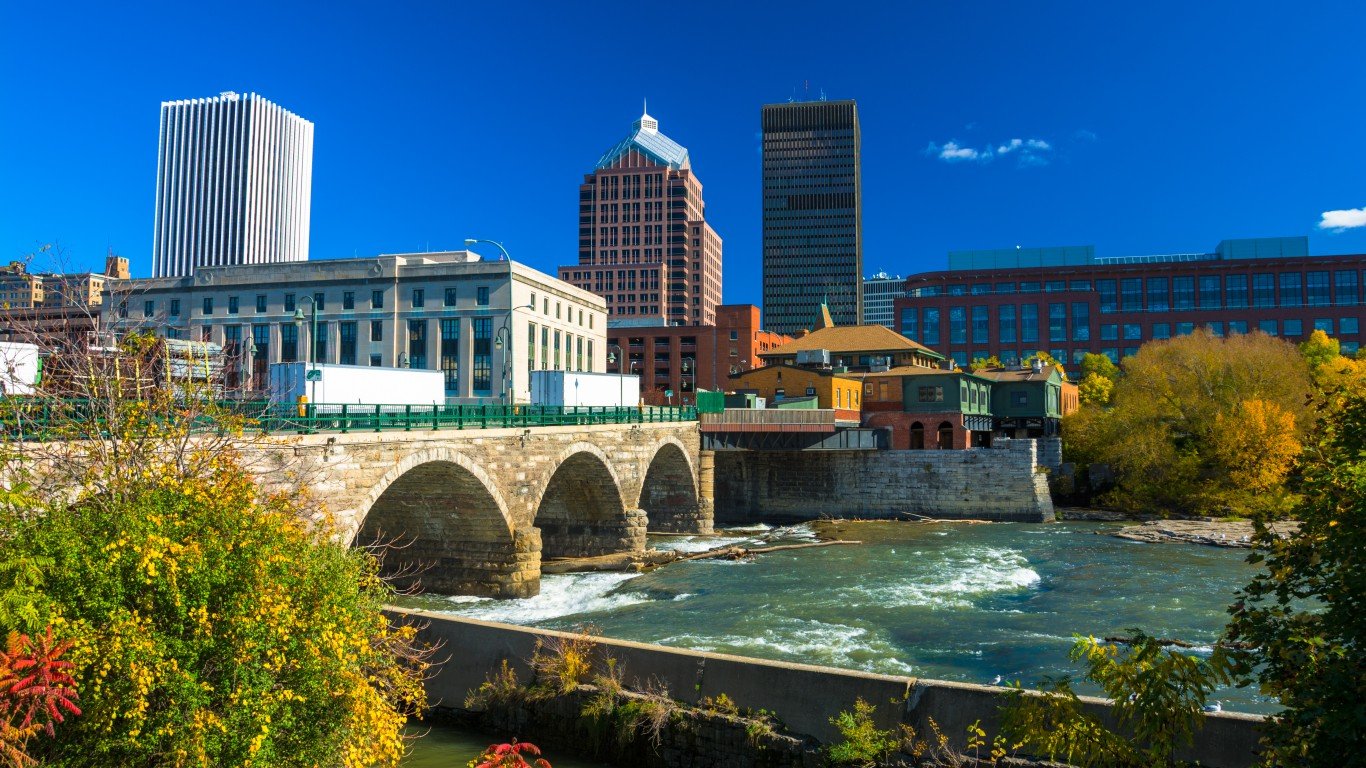
- Decline from peak population: -121,496 people
- Peak population: 332,488 (1950)
- Current population: 210,992
- Major events in city history: Opening of the Erie Canal in 1825, founding of the University of Rochester in 1850, establishment of Eastman Kodak Company by George Eastman in 1888, Susan B. Anthony’s arrest for voting in 1872, race riots of 1964
16. Dayton, OH
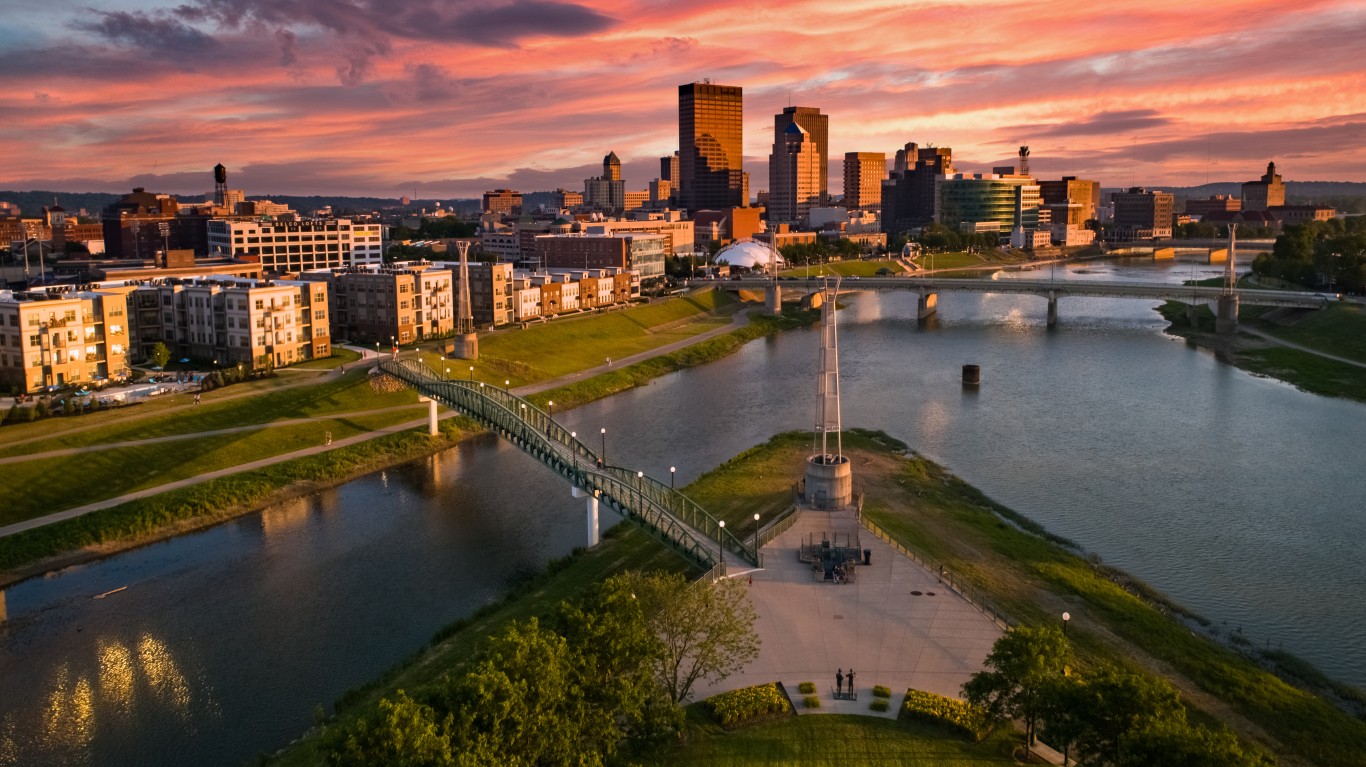
- Decline from peak population: -125,027 people
- Peak population: 262,332 (1960)
- Current population: 137,305
- Major events in city history: The Great Dayton Flood of 1913, Wright brothers’ first powered flight in 1903, establishment of Wright-Patterson Air Force Base in 1948, founding of the National Cash Register Company (NCR) in 1884, signing of the Dayton Agreement in 1995
15. Washington, DC
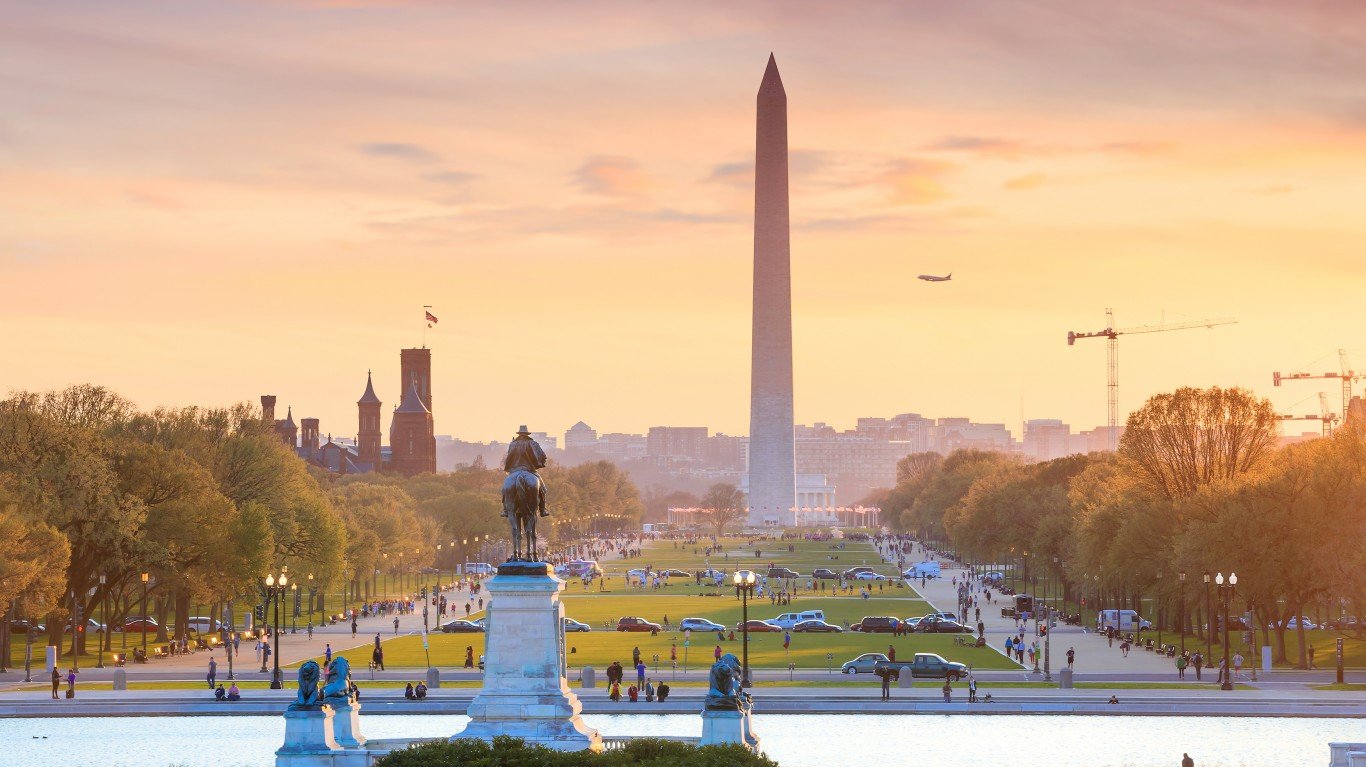
- Decline from peak population: -131,591 people
- Peak population: 802,178 (1950)
- Current population: 670,587
- Major events in city history: Burning of the White House in 1814, March on Washington of 1963, establishment of the Smithsonian Institution in 1846, dedication of the Lincoln Memorial in 1922
14. Newark, NJ
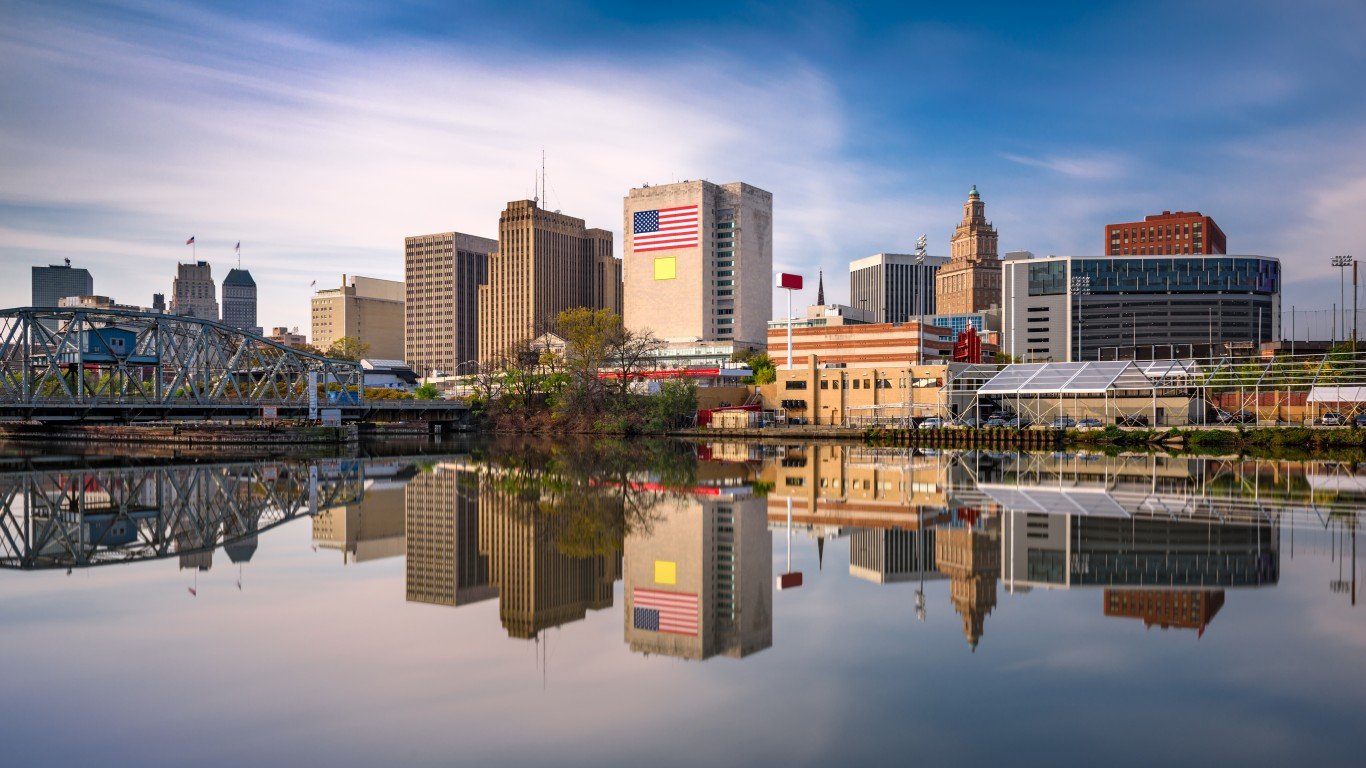
- Decline from peak population: -134,982 people
- Peak population: 442,337 (1930)
- Current population: 307,355
- Major events in city history: Founding of Prudential Financial in 1875, Newark riots of 1967, establishment of Newark Liberty International Airport in 1928, opening of the New Jersey Performing Arts Center in 1997, revitalization of downtown Newark in the 21st century
13. Boston, MA
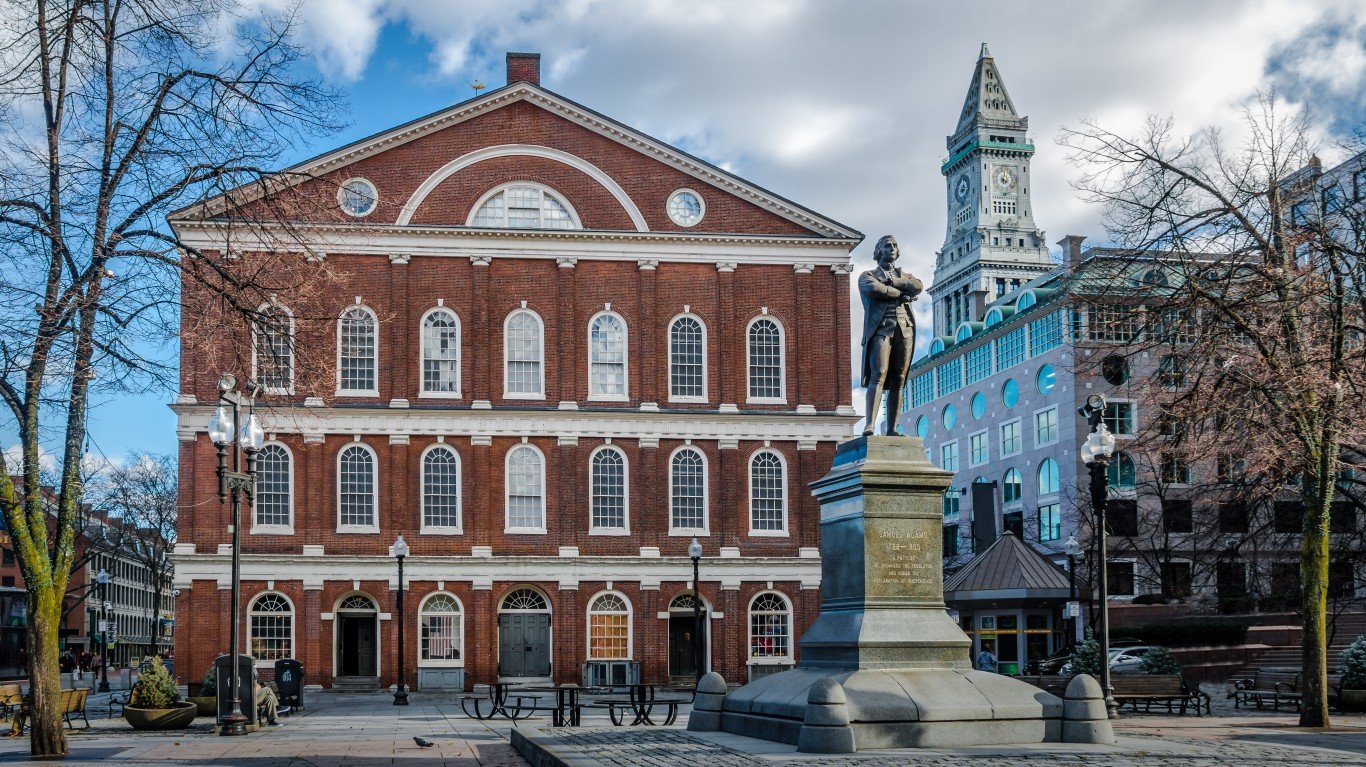
- Decline from peak population: -135,499 people
- Peak population: 801,444 (1950)
- Current population: 665,945
- Major events in city history: Boston Massacre of 1770, Boston Tea Party of 1773, Great Molasses Flood of 1919, opening of Fenway Park in 1912, Boston Marathon bombing in 2013
12. Birmingham, AL
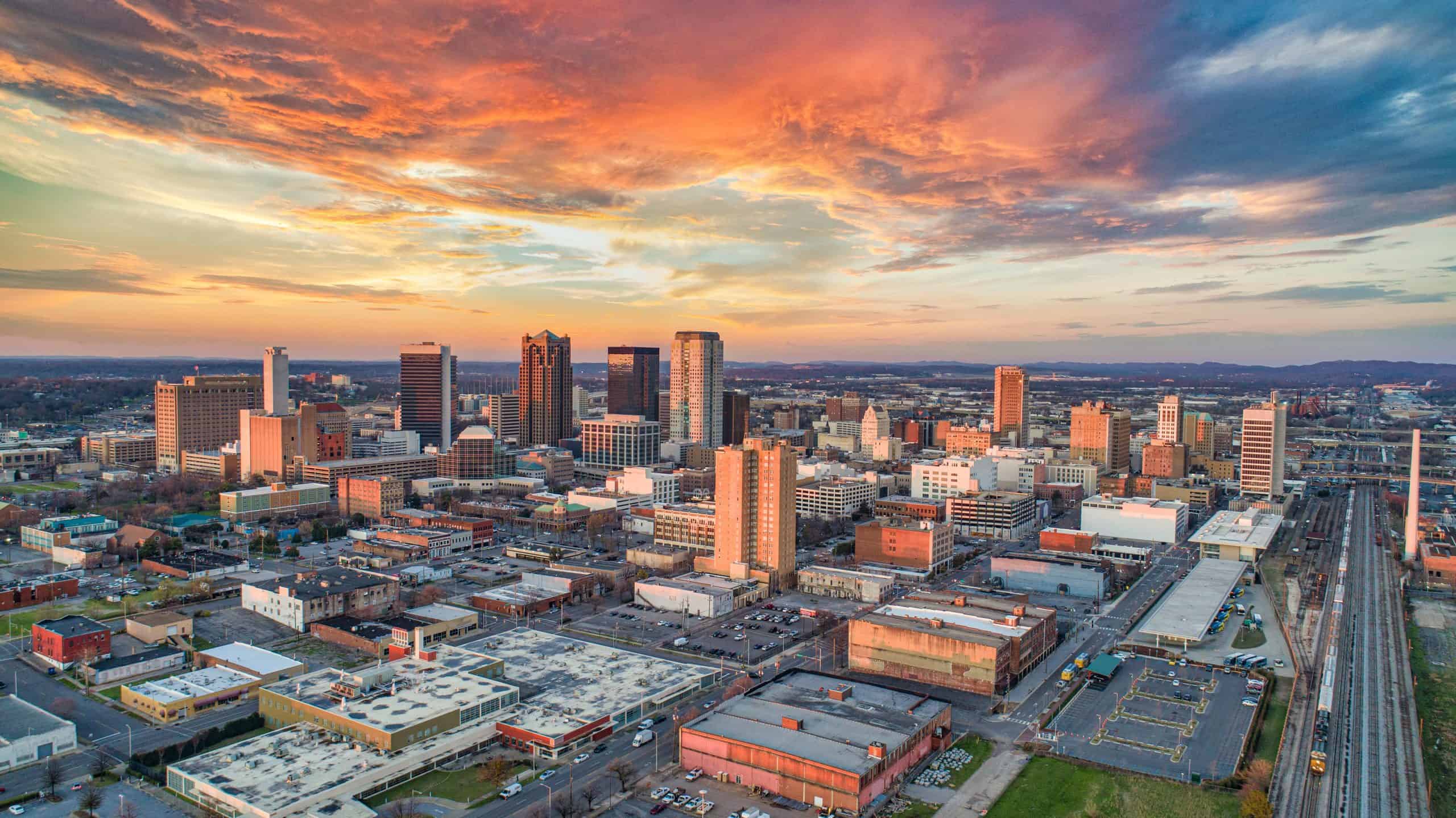
- Decline from peak population: -140,456 people
- Peak population: 340,887 (1960)
- Current population: 200,431
- Major events in city history: Founding of Birmingham in 1871, rapid industrial growth due to iron and steel production in the late 19th century, Birmingham campaign and civil rights protests in 1963, 16th Street Baptist Church bombing in 1963, revitalization of downtown Birmingham in the 21st century
11. Milwaukee, WI
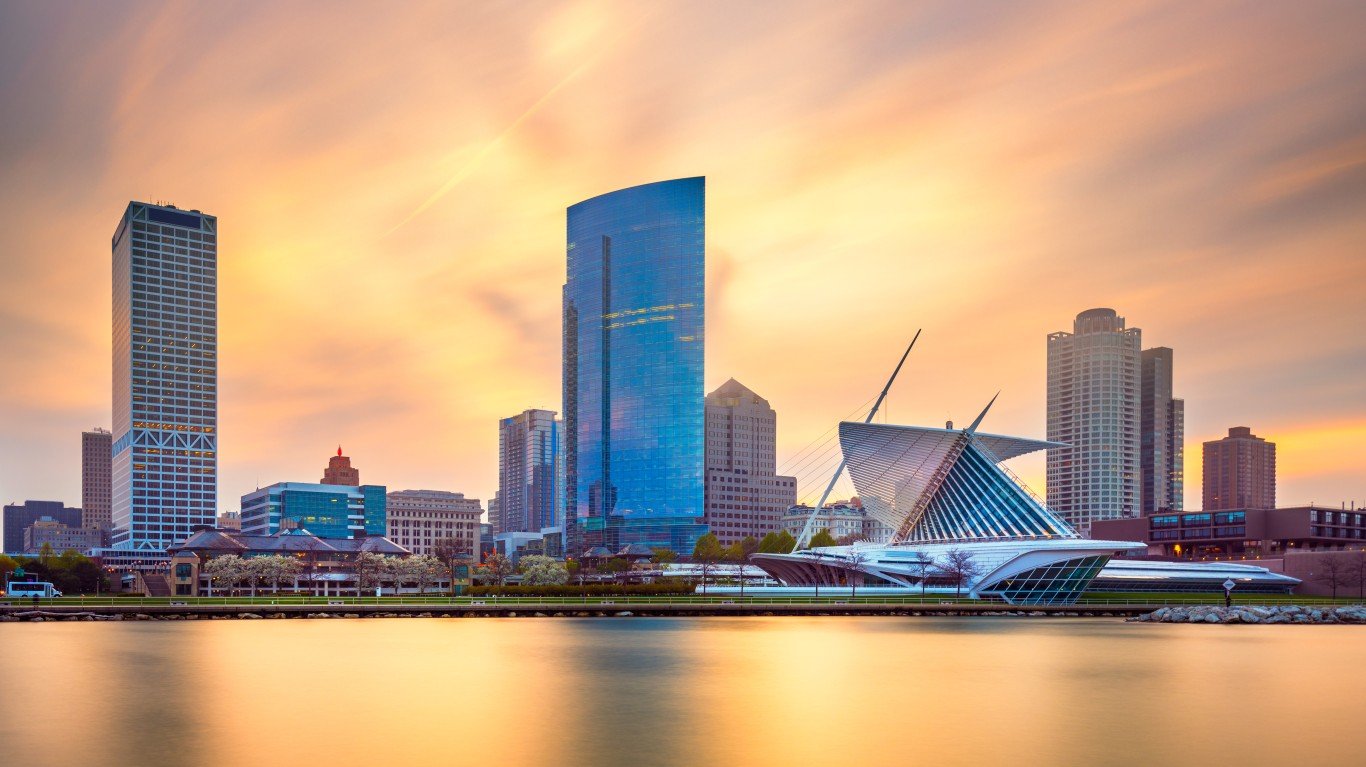
- Decline from peak population: -168,025 people
- Peak population: 741,324 (1960)
- Current population: 573,299
- Major events in city history: Founding of the Milwaukee Brewers Association in 1849, establishment of major breweries like Pabst, Schlitz, and Miller in the 19th century, Milwaukee Bridge War of 1845, Milwaukee Braves’ World Series win in 1957, opening of the Milwaukee Art Museum’s Quadracci Pavilion in 2001
10. Cincinnati, OH
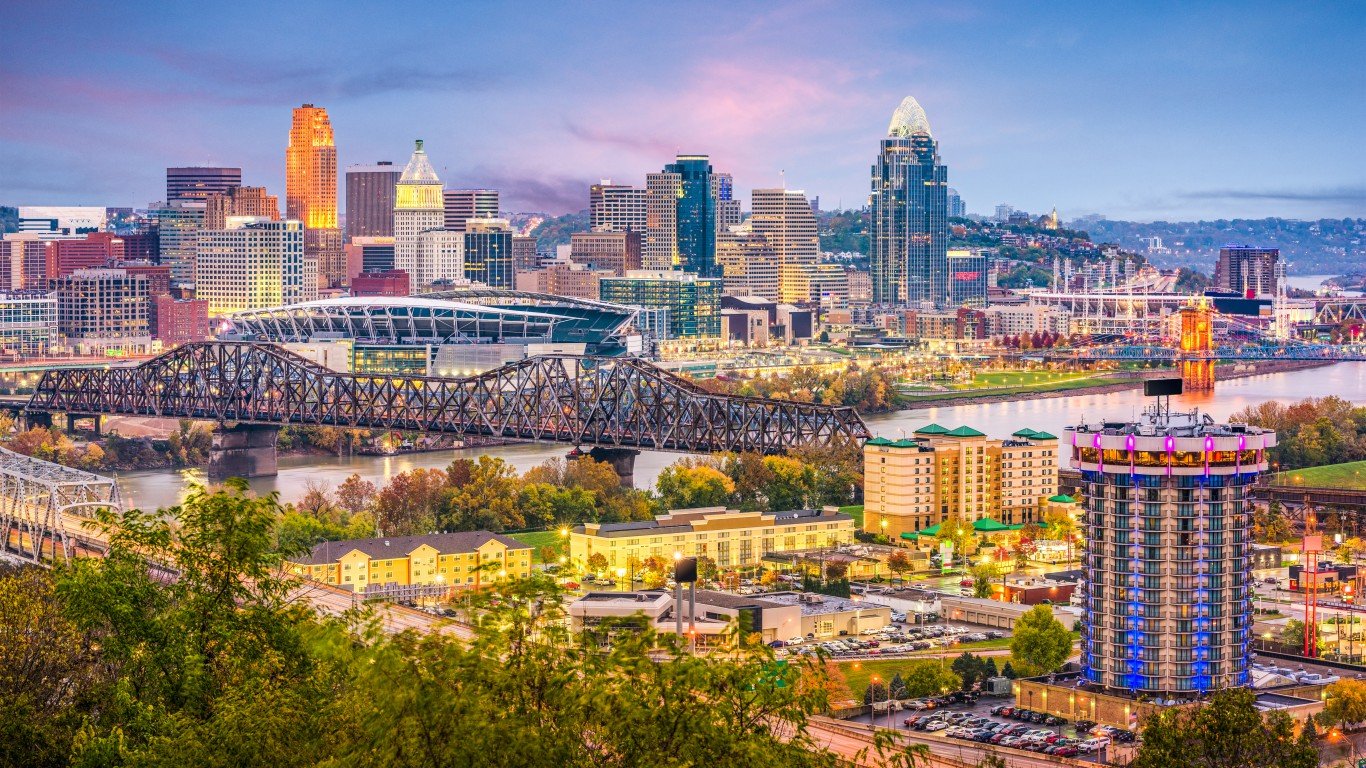
- Decline from peak population: -195,128 people
- Peak population: 503,998 (1950)
- Current population: 308,870
- Major events in city history: Completion of the Miami and Erie Canal in 1827, establishment as a major pork processing center (‘Porkopolis’) in the 19th century, Cincinnati Red Stockings becoming the first professional baseball team in 1869, Cincinnati riots of 1884
9. New Orleans, LA
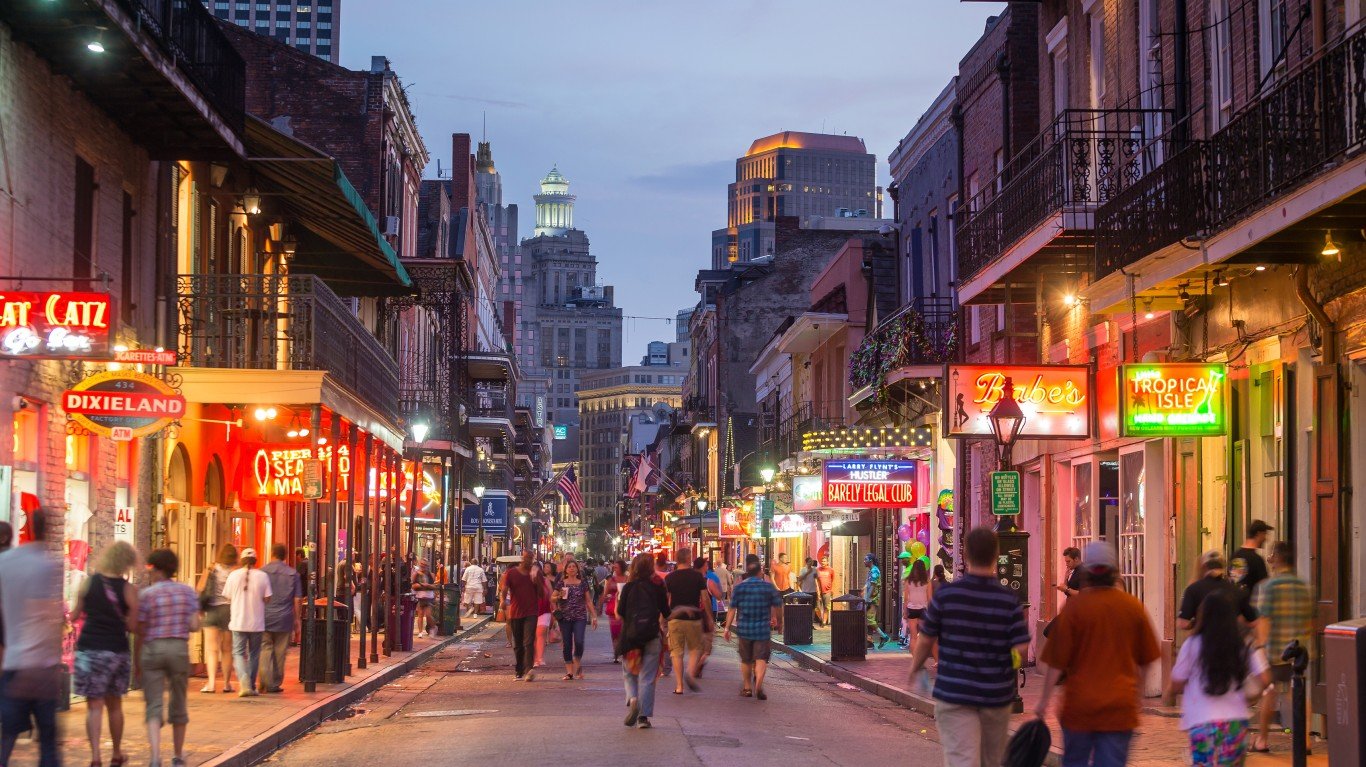
- Decline from peak population: -247,117 people
- Peak population: 627,525 (1960)
- Current population: 380,408
- Major events in city history: Battle of New Orleans in 1815, Louisiana Purchase in 1803, establishment of Mardi Gras celebrations in the 19th century, Hurricane Betsy in 1965, Hurricane Katrina in 2005
8. Buffalo, NY
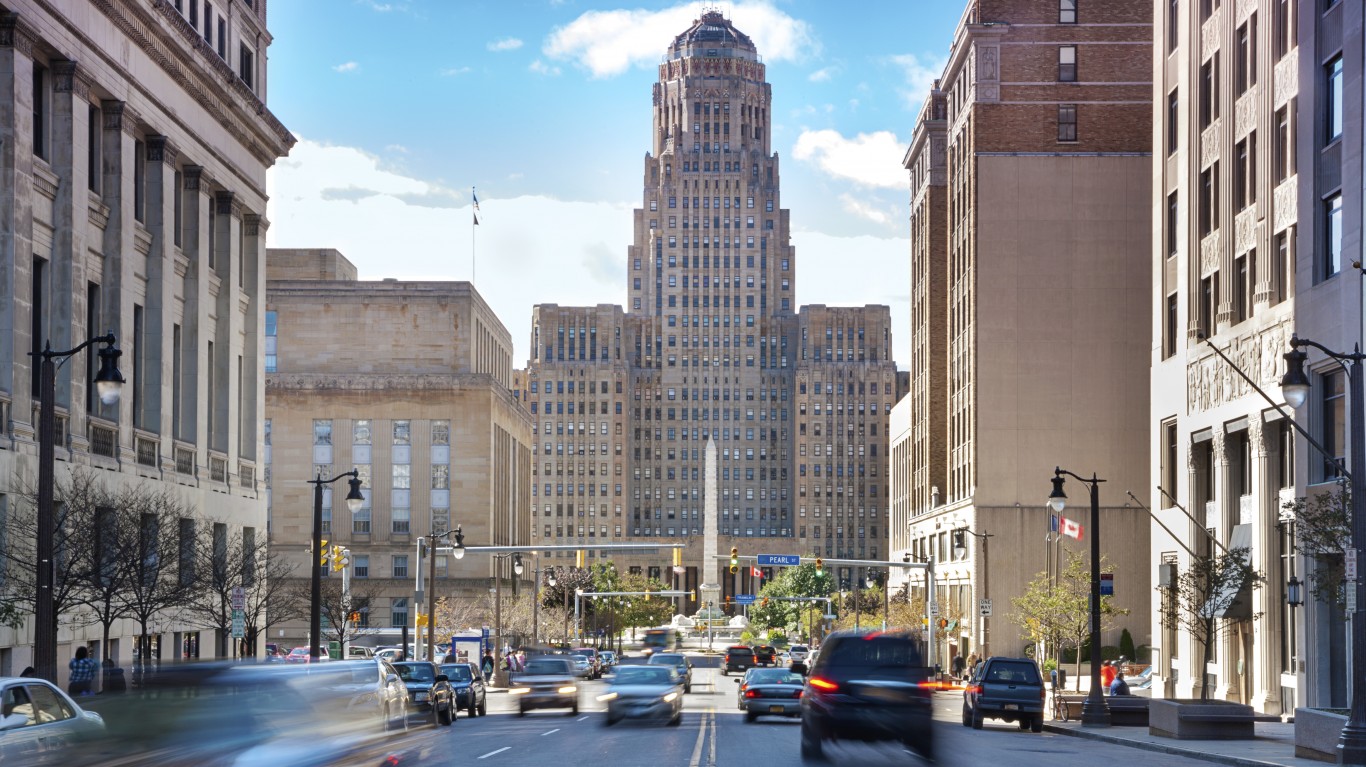
- Decline from peak population: -303,444 people
- Peak population: 580,132 (1950)
- Current population: 276,688
- Major events in city history: Completion of the Erie Canal in 1825, Pan-American Exposition of 1901, assassination of President William McKinley in 1901, Buffalo Bills’ four consecutive Super Bowl appearances (1990-1993), decline of the steel industry in the 1970s and 1980s
7. Baltimore, MD
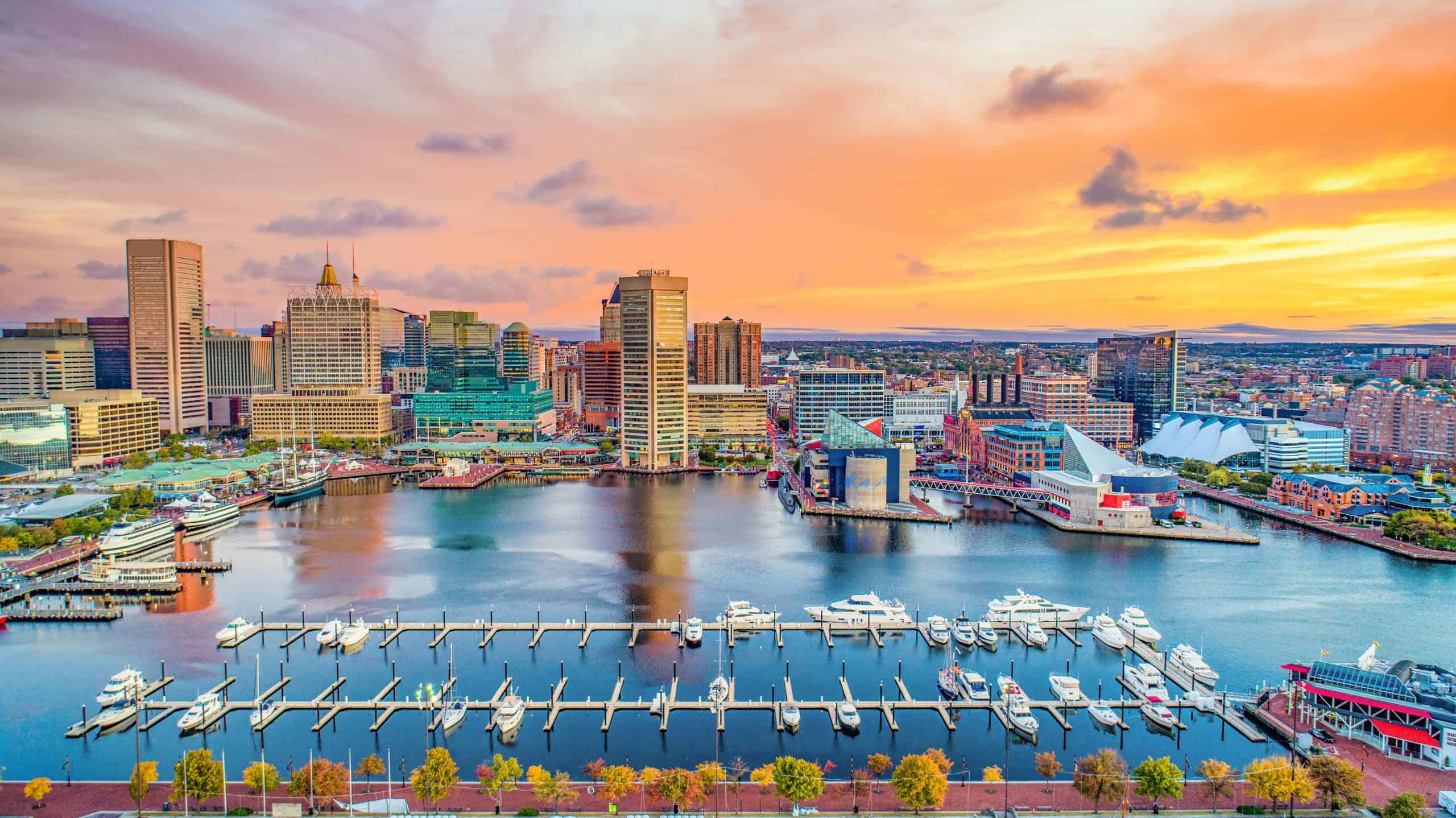
- Decline from peak population: -365,160 people
- Peak population: 949,708 (1950)
- Current population: 584,548
- Major events in city history: Battle of Baltimore during the War of 1812, founding of the Baltimore and Ohio Railroad in 1827, Great Baltimore Fire of 1904, Baltimore Orioles’ first World Series win in 1966, opening of the National Aquarium in 1981
6. Pittsburgh, PA
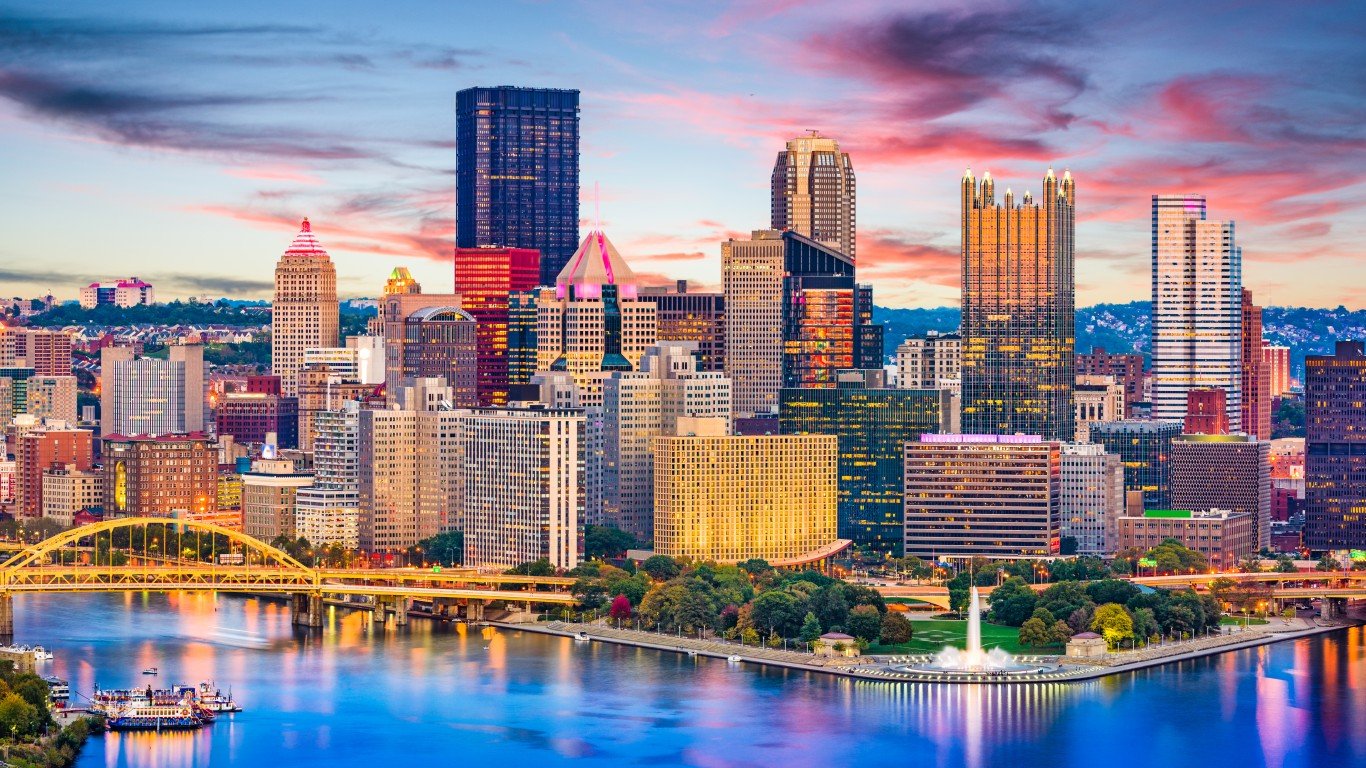
- Decline from peak population: -372,963 people
- Peak population: 676,806 (1950)
- Current population: 303,843
- Major events in city history: Establishment of the Pittsburgh Plate Glass Company in 1883, founding of Carnegie Steel Company in 1892, Pittsburgh Pirates’ first World Series win in 1909, air pollution crisis leading to the ‘Smoky City’ nickname in the early 20th century, urban renewal project in the 1950s
5. Philadelphia, PA
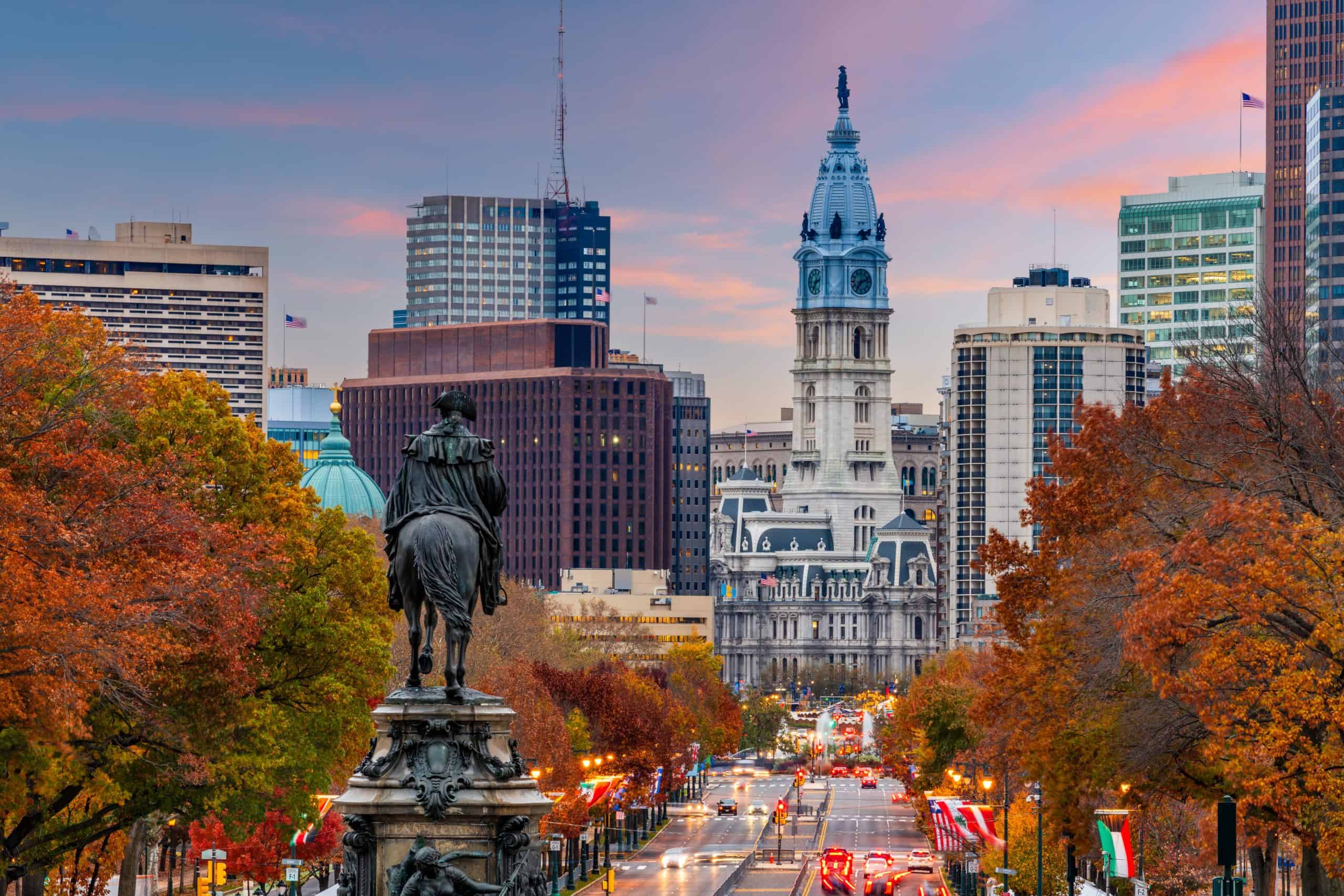
- Decline from peak population: -478,397 people
- Peak population: 2,071,605 (1950)
- Current population: 1,593,208
- Major events in city history: Signing of the Declaration of Independence in 1776, Constitutional Convention of 1787, Yellow Fever Epidemic of 1793, Centennial Exposition of 1876, Philadelphia Phillies’ first World Series win in 1980
4. Cleveland, OH
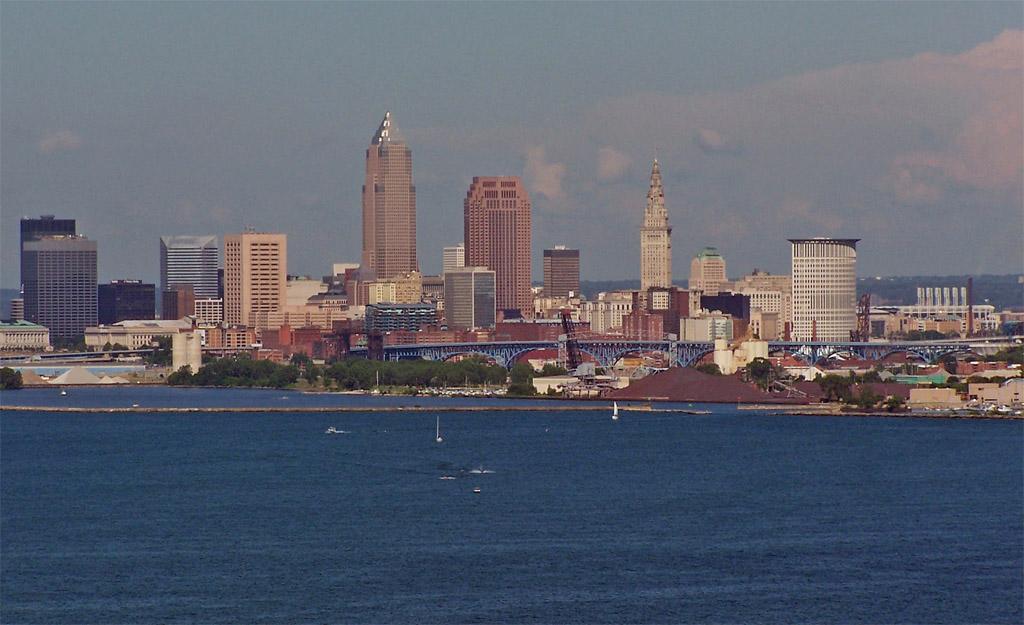
- Decline from peak population: -544,443 people
- Peak population: 914,808 (1950)
- Current population: 370,365
- Major events in city history: Founding of Standard Oil by John D. Rockefeller in 1870, Cuyahoga River Fire of 1969, Cleveland Indians’ (now Guardians) World Series wins in 1920 and 1948, opening of the Rock and Roll Hall of Fame in 1995
3. St. Louis, MO
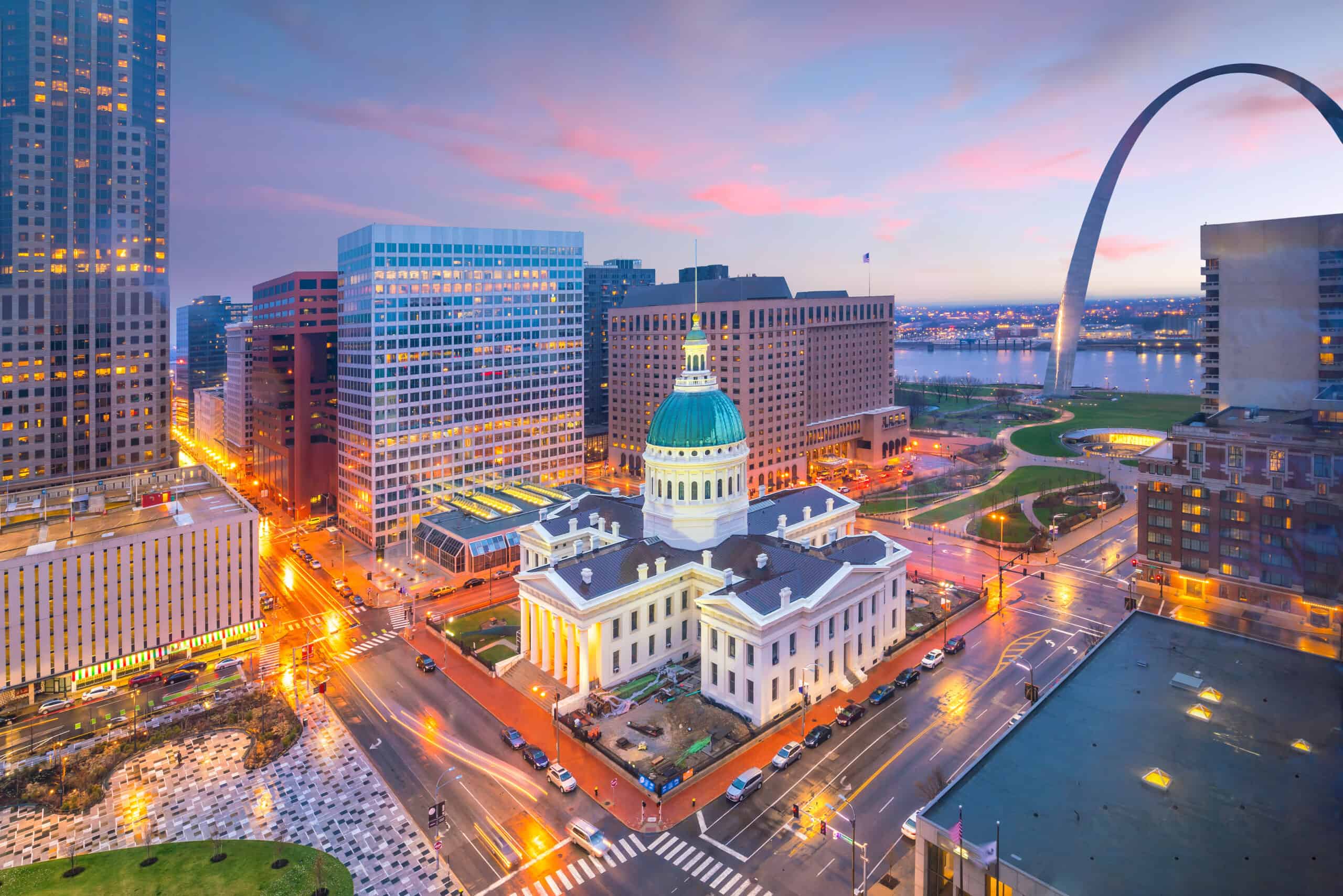
- Decline from peak population: -558,778 people
- Peak population: 856,796 (1950)
- Current population: 298,018
- Major events in city history: Louisiana Purchase Exposition (World’s Fair) of 1904, completion of the Gateway Arch in 1965, St. Louis Cardinals’ first World Series win in 1926, Dred Scott Case decision in 1857, 1904 Summer Olympics
2. Chicago, IL
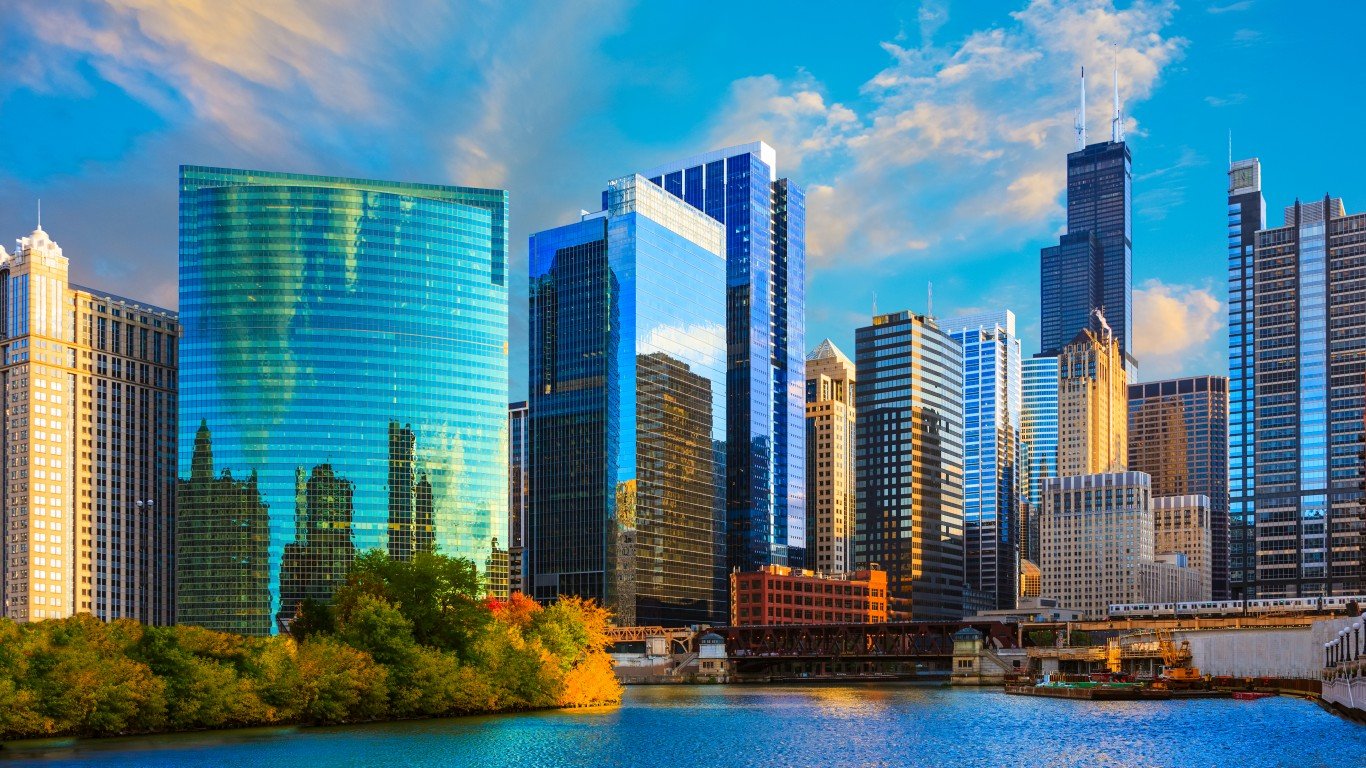
- Decline from peak population: -899,048 people
- Peak population: 3,620,962 (1950)
- Current population: 2,721,914
- Major events in city history: The Great Chicago Fire of 1871, World’s Columbian Exposition of 1893, Chicago Race Riot of 1919, St. Valentine’s Day Massacre of 1929, opening of the Willis Tower (formerly Sears Tower) in 1973
1. Detroit, MI
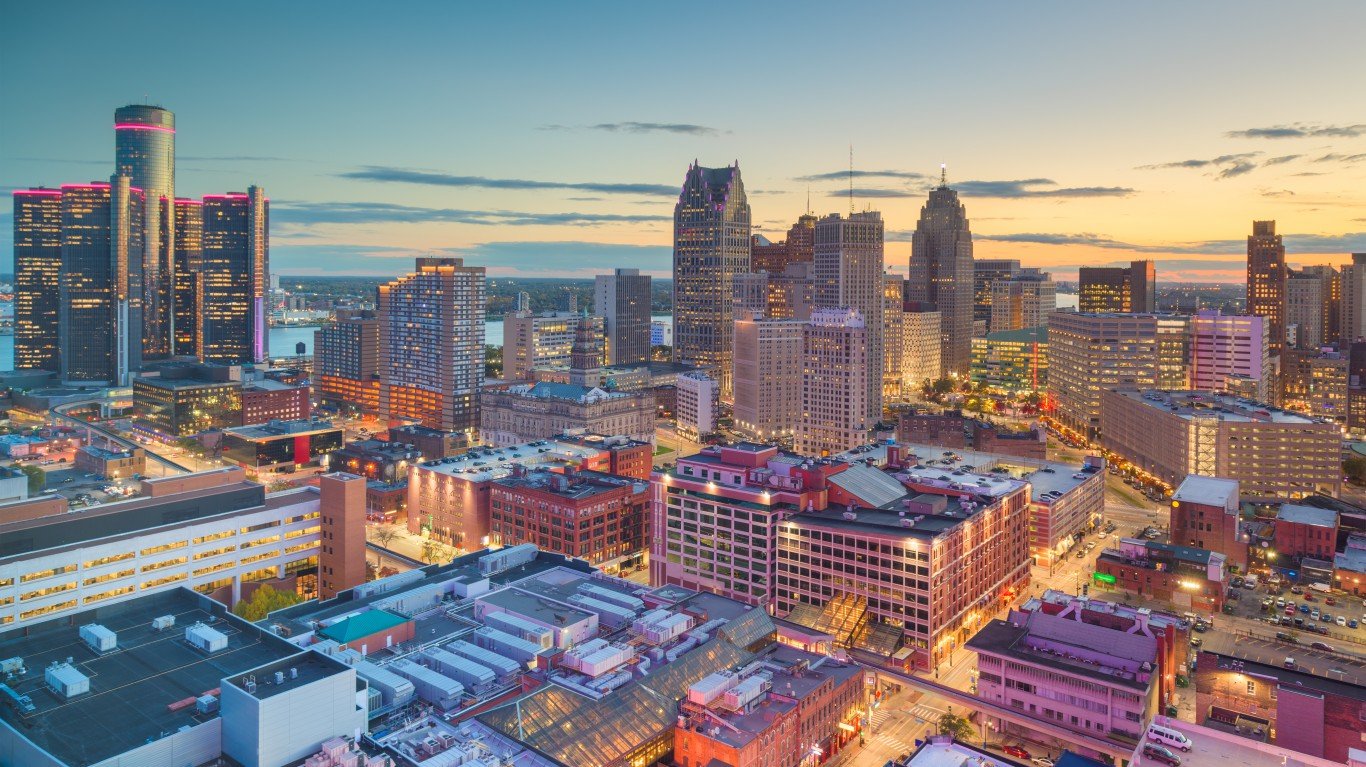
- Decline from peak population: -1,212,781 people
- Peak population: 1,849,568 (1950)
- Current population: 636,787
- Major events in city history: The Great Fire of 1805, Ford Motor Company founded in 1903, Detroit Race Riot of 1943, 12th Street Riot of 1967, Detroit Bankruptcy in 2013
The post New Orleans Is Still 100,000 People Smaller Than Before Katrina. Here Are Other Major Cities Still Recovering From Their Peak Population appeared first on 24/7 Wall St..

